D Link WR810A1 DC-HSPA+ Le Petit Router User Manual DWR 810 UserMan
D Link Corporation DC-HSPA+ Le Petit Router DWR 810 UserMan
D Link >
User Manual
User Manual
For
DWR-810
Introduction
High-Speed Mobile Internet with 3G Connectivity
The DWR-810 HSPA+ Mobile Router gives you high-speed access to the
Internet wherever you are and lets you share it on the go.
The built-in 3G antenna provides a reliable connection to your 3G service
provider, and a separate Wi-Fi antenna gives extended coverage to the
computers and mobile devices connected to the DWR-810.
Mobile Internet for All of Your Devices
With the DWR-810, you can get online with your notebook, smartphone, tablet,
or any other wireless device using a single 3G mobile connection. The
DWR-810 provides high-speed Wireless N coverage to give high-speed
wireless access to everybody – whether you are with colleagues on a
business trip, or travelling with friends and family.
Built-in Software for Instant Access Anywhere
The DWR-810 is truly plug and play, with drivers built right into the router so
you can connect without the need to install anything. Open a browser,
connect the router, and you can set up your network right from a web interface.
This means that notebooks and netbooks without a CD‑ROM drive can
connect and get up and running in no time. Once the device is set up, you can
simply power it on to start up your portable mobile network, meaning
that you can share your mobile Internet connection without even needing a
computer.
Designed for True Portability
The DWR-810 HSPA+ Mobile Router is small and slim enough to carry around
in your purse, bag, or pocket. It features a MicroSD card slot for optional
removable storage (up to 32 GB), allowing you to always have your files and
contacts on hand.
Installation
This section will guide you through the installation process.
Connect to Your Network
1. Ensure that your DWR-810 HSPA+ Mobile Router is powered off.
2. Slide your (U)SIM card into the slot provided, ensuring that the alignment is
the same as indicated by the logo next to the slot. The gold contacts on the
card should be facing downwards.
Caution: Always unplug and turn off the router before installing or removing the
SIM card.
Never insert or remove the SIM card while the router is in use.
3. After a few moments, the OLED display will show the current status of the
router’s various functions.
Insert a microSD Card
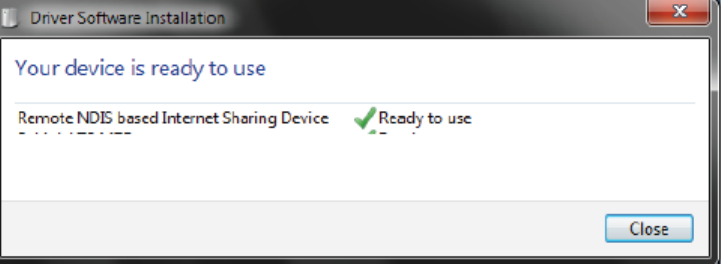
1. Ensure that your DWR-810 HSPA+ Mobile Router is powered off.
2. Open the cover of the microSD slot on the side of the router.
3. Insert the microSD card into the slot and push it in until it locks into place.
Driver Installation
When you plug the DWR-810 into your computer, any necessary drivers will
immediately install (with your permission).
Note: These drivers are Windows-only. Mac and Linux users will still be able to
configure the DWR-810 using the web configuration utility described in
Configuration Utility.
Note: For Windows systems, if there are any problems while installing the
driver, please make sure you have installed Windows Media player version 11
or higher.
Wireless Installation
Considerations
The DWR-810 can be accessed using a wireless connection from anywhere
within the operating range of its wireless network. Keep in mind that the
quantity, thickness, and location of walls, ceilings, or other objects that the
wireless signals must pass through may adversely affect wireless signals.
Ranges vary depending on the types of materials and background RF (radio
frequency) noise in your home or office. The key to maximizing the wireless
range is to follow these basic guidelines:
1. Minimize the number of walls and ceilings between the router and other
network devices. Each wall or ceiling can reduce your adapter’s range
From1 to 90 feet (1 to 30 meters).
2. Be aware of the direct line between network devices. A wall that is 1.5 feet
thick (0.5 meters) appears to be almost 3 feet (1 meter) thick at a 45-degree
angle. At a 2-degree angle it appears over 42 feet (14 meters) thick. Position
devices so that the signal will travel straight through a wall or ceiling (instead of
at an angle) for better reception.
3. Try to position access points, wireless routers, and computers so that the
signal passes through open doorways and drywall. Materials such as glass,
metal, brick, insulation, concrete, and water can affect wireless performance.
Large objects such as fish tanks, mirrors, file cabinets, metal doors, and
aluminum studs may also have a negative effect on range.
4. If you are using a 2.4 GHz cordless phone, make sure that the 2.4 GHz
phone base is as far away from your wireless device as possible. The base
transmits a signal even if the phone is not in use. In some cases, cordless
phones, X-10 wireless devices, and electronic equipment such as ceiling fans,
fluorescent lights, and home security systems may dramatically degrade
wireless connectivity.
Configuration
Initial Connection to the Router
This section will show you how to configure your new mobile router using the
configuration utility that can be obtained through a software interface or a
web-based user interface.
When configuring the router for the first time, you will need to establish a direct
connection with the router in order to access the web-based configuration
utility. This can be done using the included USB, or by connecting wirelessly to
the DWR-810. Once you have configured your router, you will be able to
connect using the Wi-Fi settings that you have specified in the configuration
process. Ensure that the router is powered on and has sufficient battery power
before commencing the setup process.
Connect via USB
To connect to the router via USB, plug the provided micro USB cable into the
micro USB port on the bottom of the router, and plug the other end
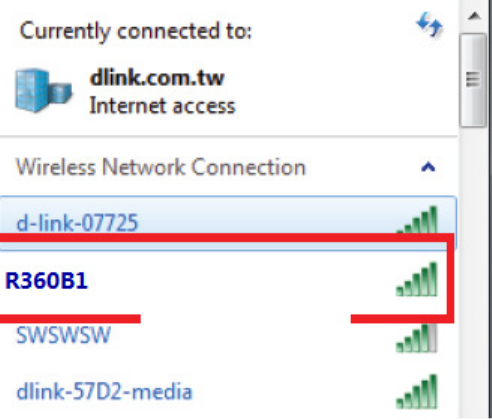
into an available USB port on your computer. Your router is now ready for
configuration, please refer to Configuration Utility on page 12 to continue the
setup process.
Connect via Wi-Fi
Note: The following example uses Windows 7’s built-in wireless connection
utility. If you are using a different operating system, or a third party connection
utility, the process may be different. Please refer to the documentation that
came with your operating system or wireless client for further information on
how to connect to a wireless network.
To connect to the router using Wi-Fi, open your operating system’s wireless
networking utility and scan for available networks to connect to. By default, the
network name (SSID) of the DWR-810 will be in the format DWR-810,the
default password is 1234567890
Once you have located this network with your wireless utility, connect to the
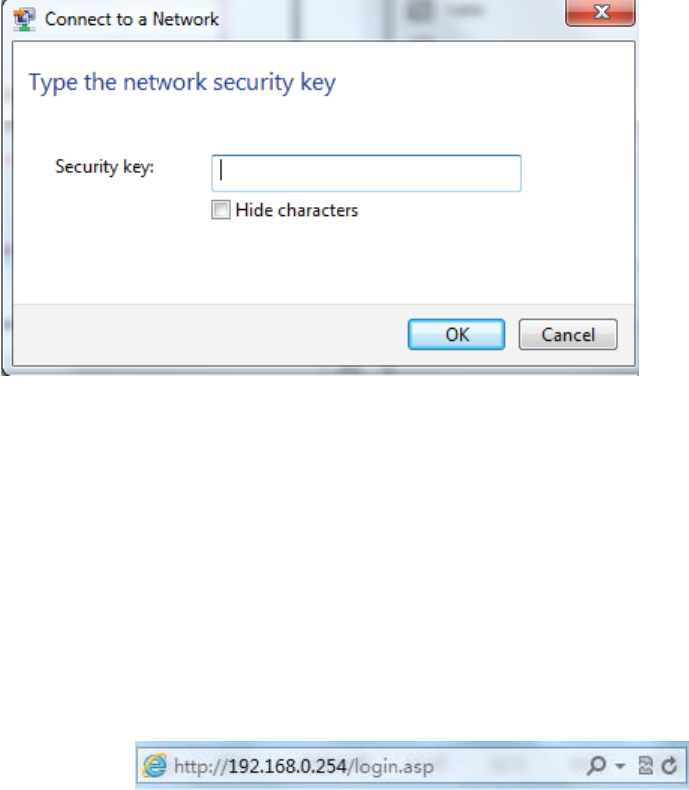
network using your wireless networking utility.
You will then be prompted to enter the network security key for your router.
The unique security key for your router will be displayed on a sticker in the
router’s battery bay. Enter the security key in the box provided and click OK.
Your wireless connection utility should confirm that the connection is
successful, and you can move to the next step to continue to configuration
process.
Web-based Configuration
To access the configuration utility, open a web browser (such as Internet
Explorer) and enter the IP address of the router, which is 192.168.0.254 by
default.
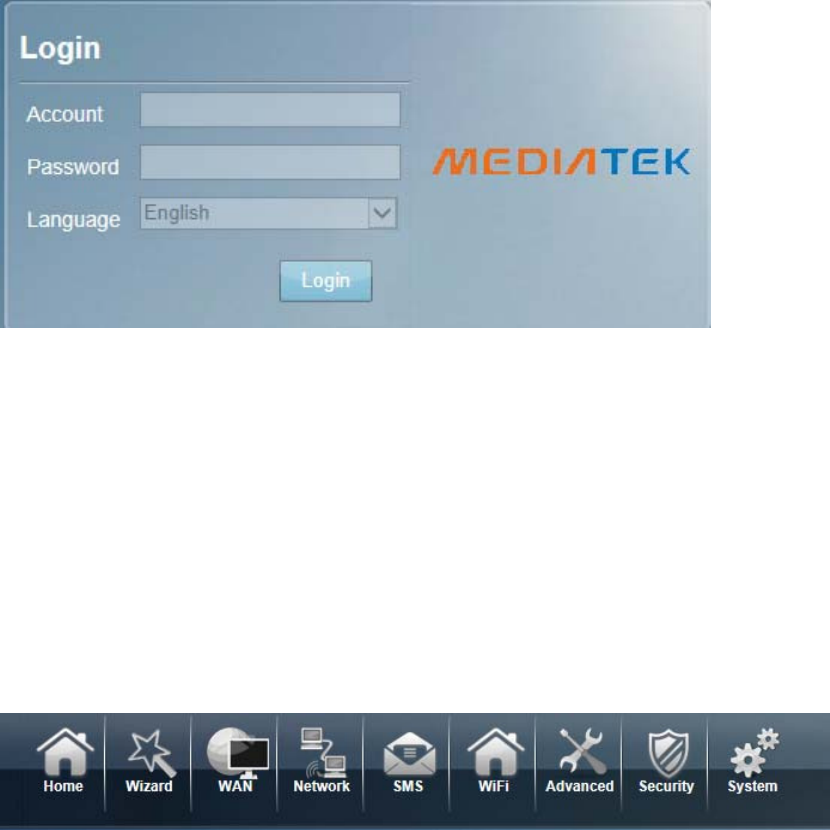
Configuration Utility
Once you have reached the configuration utility through the installed software
or your web browser, you will need to log in. Enter admin as the username and
the password . You can also select your language from the drop-down menu.
Click Login to continue.
Home
Throughout the interface you will find a menu bar at the top of the page which
includes tabs for easy navigation, and a summary bar in the upper right corner
with a quick view of essential information.
Home: The Home tab will return you the home page, where a summary of the
system information is shown.
Wizard: Click on this tab to start the setup wizard, which will guide you through
the basic setup process.
Internet: The WAN tab gives you Internet setup and settings options.
Network: The Network tab allows you to configure the network settings for your
Local Area Network (LAN).
SMS: From the SMS you can view and send SMS messages via your mobile
network.
Wi-Fi: The Wi-Fi allows you to configure your Wi-Fi network, as well as add
new devices using WPS.
Advanced: Use this tab to configure advanced network settings such as
routing and IPv6.
Security: The Security allows you to configure firewall and security settings to
protect your network from WAN-side
intrusions.
system: From this tab, you can manage the administrative configuration of
your router, such as time and date, firmware,
language, and remote management.
Device Status
A summary of the device’s current status will be displayed on the information
panel at the top of the right-hand side of the navigation bar. The following is a
description of the indications, from left to right.

SIM: This icon shows whether or not a compatible (U)SIM card has been
inserted into the device.
SMS: The number to the right of this icon indicates the number of unread
messages in the SMS inbox.
Signal Strength: Indicates the current strength of the mobile network signal
being received.
Operator Name: The name of the mobile network operator to which the device
is currently connected.
Internet: Indicates that there is an Internet connection present
Wi-Fi Network: Indicates that the router’s Wi-Fi network is currently active. The
number to the right of this icon indicates the number
of wireless clients currently connected to the router’s Wi-Fi network.
Logout: Click this button to log out of the configuration interface.
Home
The Home page acts as a dashboard to quickly display your configuration
settings and provide a summary of the current status of your network’s status.
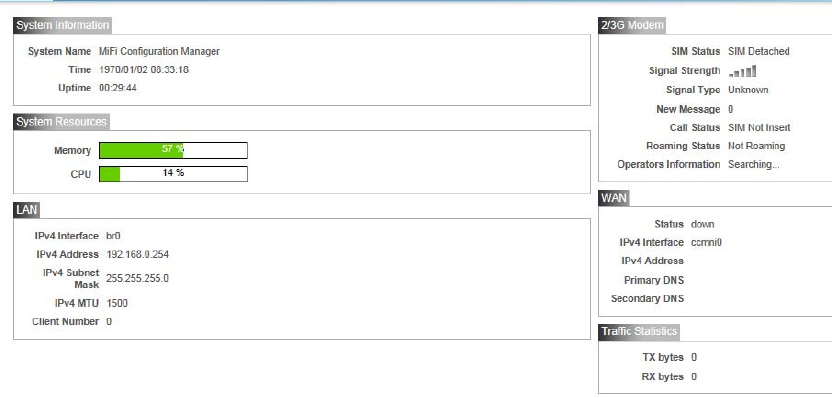
System Resources: This area displays the percentage of the router’s memory
and CPU currently being used by the system.
LAN: This area displays a summary of the current settings for the router’s LAN.
2G/3G Modem: This area shows the current status of your 2G or 3G mobile
network connection.
WAN: This area displays a summary of the router’s current WAN settings.
These details will reflect the mobile network connection which is being
received from the service provider.
Traffic Statistics: This area shows the amount of data which has been sent (TX)
and received (RX) over the mobile network. This information may not reflect
the amount recorded by your mobile service provider.
Wizard
The Wizard page will guide you through the steps required to configure the
basic settings of your router such as the IP address, network name (SSID),
and password. Click on the Wizard button on the navigation bar to commence
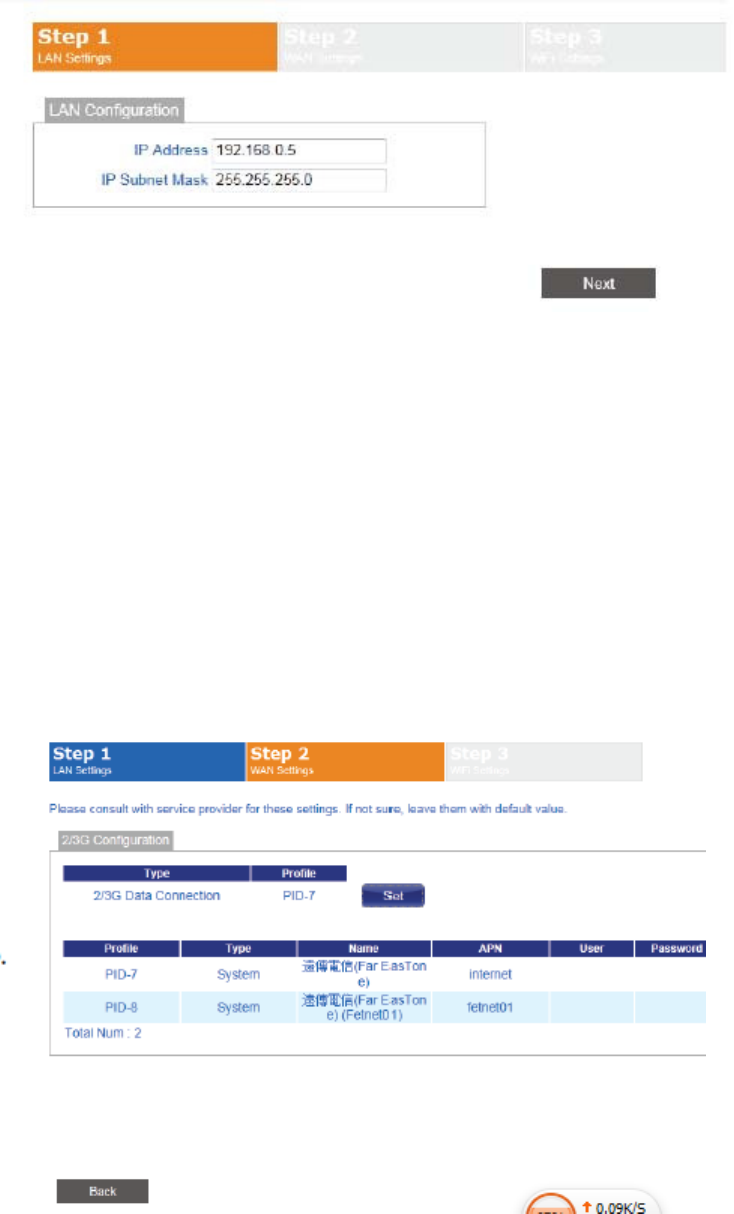
the wizard.
LAN Configuration
IP Address: If you wish to change the router’s IP address, enter the new
address here. If you change the IP address from the default, you will need to
enter the new address in your Internet browser’s address bar in order to
access the web-based configuration utility.
IP Subnet Mask: If you wish to change the router’s subnet mask, enter it here.
Click Next to continue.
2/3G Configuration
\If you wish to change the 2G or 3G service provider or connection type, click
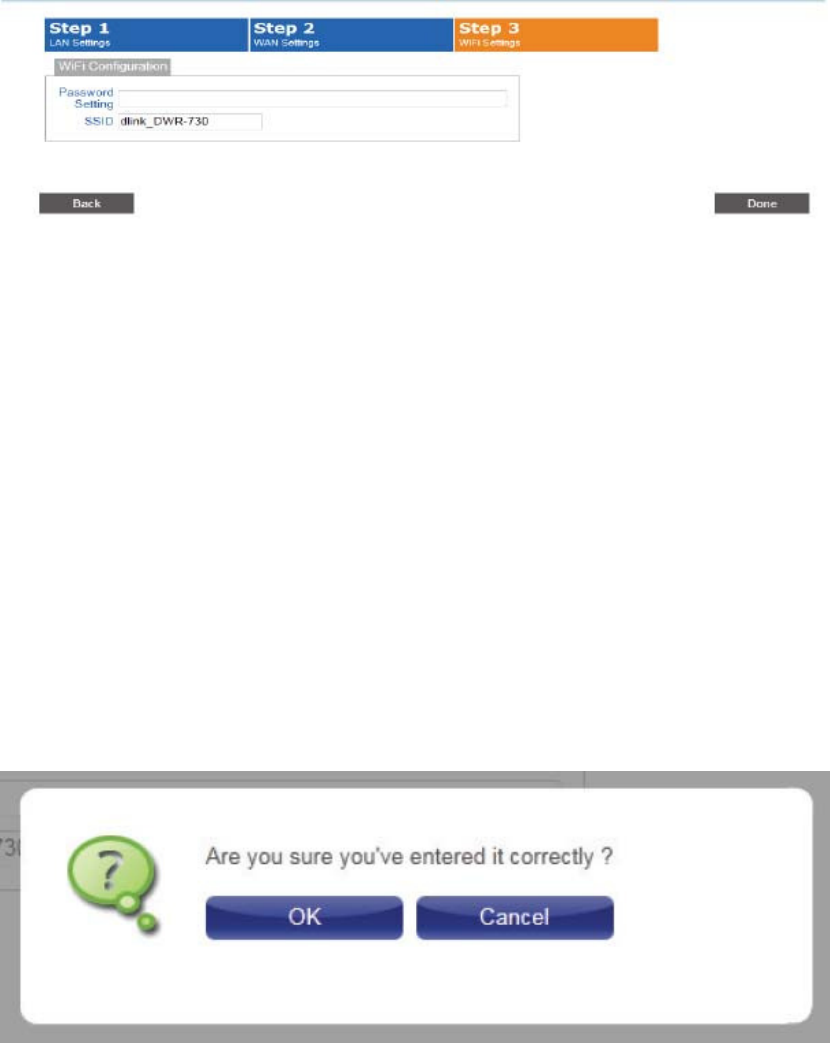
on a profile in the list to highlight it, and click Set to set that profile as the
default.
Click Next to continue, or Back to return to the previous step.
Wi-Fi Configuration
Password Setting: Choose a password for your wireless security. Clients will
need this password in order to access your network wirelessly. If you are
currently connected to the router using Wi-Fi, you will need to reconnect to the
router using your new password once the wizard has been completed.
SSID: If you wish to change your wireless network name (SSID), enter a new
name in the field provided. If you change the SSID, you may need to
re-connect to the router using the new SSID before you can access your
network or the configuration utility.
Click Done to complete the wizard, or click Back to return to the previous page.
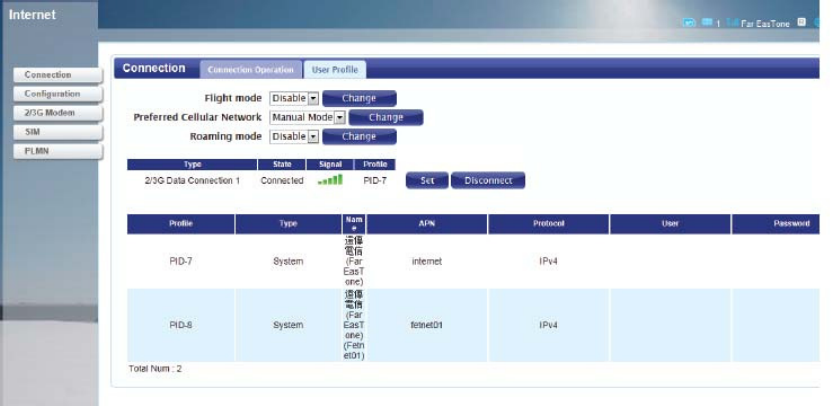
After you have clicked Done, a confirmation window will appear. Click OK to
save the configuration.
WAN
This page allows you to configure the Internet settings for your mobile network
connection. Use the tabs in the left-hand column to navigate through the
different settings categories.
Connection Operation
Flight mode :Flight mode turns off all communications so that the device can
be powered on safely when in an aircraft. Select whether you want to Enable
or Disable flight mode from the dropdown menu, and click Change to effect the
change.
Preferred Cellular Network: Select your preferred cellular network connection
mode:
Auto Mode - The router will automatically connect to your preferred mobile
network and remain connected while the device is powered on.

Manual Mode - You must manually connect to the preferred mobile network.
On Demand - The router will connect to the preferred mobile network when
Internet access is required.
Click Change to effect the change.
Roaming Mode :Select whether you would like to Enable or Disable mobile
network roaming from the drop-down menu.
Caution: Roaming on networks other than your own may incur additional
usage charges.
Connection: Shows the type and status of the current mobile connection. To
change the connection profile, select a user profile from the table below and
click Set to activate the profile. Click Disconnect to manually disconnect the
current mobile data service.
Profiles: The profiles table shows the details of currently configured user
profiles. To add a new user profile, navigate to the User Profile tab at the top of
this section.
User Profile
Click Add to add a new user profile.
Name: Enter a name to identify the new user profile.
APN: Enter the Access Point Name (APN) for the connection. If you do not
know this information, please contact your service provider.

Protocol: Select the protocol to be used for the connection from the drop-down
menu.
User: Enter the username to be used for this connection.
Password: Enter the password to be used for this connection.
Delete: Click the delete icon to delete this profile from the list. Click OK to
save the profile.
Click Apply to apply the profile settings and return to the Internet menu.
Configuration
This section allows you to specify the settings for your Internet connection
depending on the type of connection you wish to use, or as specified by your
Internet Service Provider. Use the IPv4 and IPv6 tabs at the top of the section
to select the IP address mode.
IPv4 - PDP Context
Connection Type: Select PDP Context from the drop-down menu.
DNS Setting: Enter up to three DNS servers as provided to you by your service
provider.
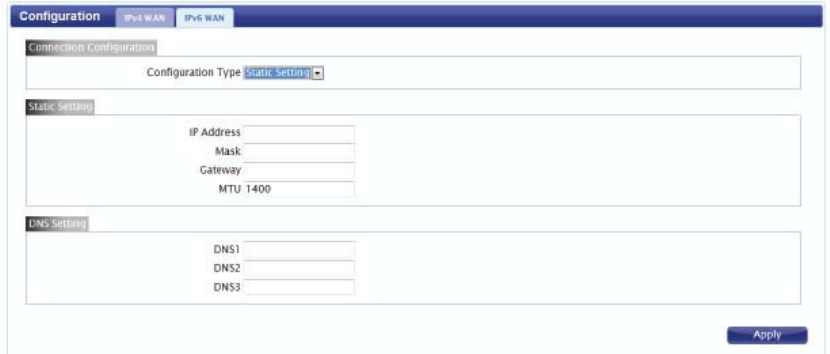
Click Apply to apply the changes.
IPv4 - Static Setting
Use this setting if your Internet Service Provider has supplied you with a static
(non-changing) IPv4 address. If you are missing any of the information
required in this section, please contact your ISP.
Connection Type: Select Static Setting from the drop-down menu.
IP Address: Enter the static IP address provided to you by your ISP.
Mask: Enter the subnet mask provided to you by your ISP.
Gateway: Enter the default gateway provided to you by your ISP.
MTU: Enter the maximum transmission unit for this connection.
The default MTU is 1400.
DNS Setting: Enter up to three DNS servers as provided to you by your ISP.
Click Apply to apply the changes.
IPv4 - DHCPv4
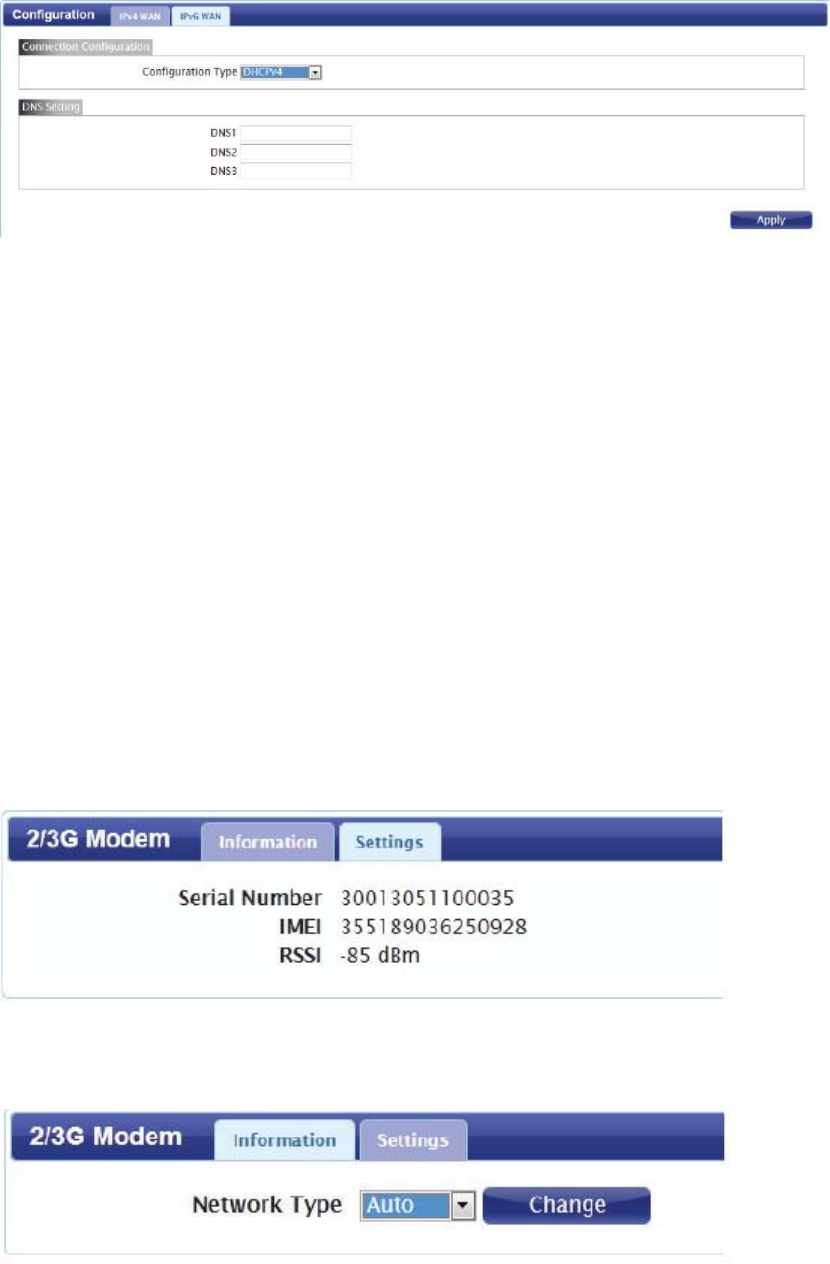
Use this setting if your Internet connection settings and IP address are to be
obtained automatically from your ISP.
Connection Type: Select DHCPv4 from the drop-down menu.
DNS Setting: Enter up to three DNS servers as provided to you by your service
provider.
Click Apply to apply the changes.
2G/3G Modem
This section displays information about your 2G or 3G modem connection.
Information
Information: Displays information about your 2G or 3G modem.
Settings
Network: Select your preferred modem type from the drop-down menu:
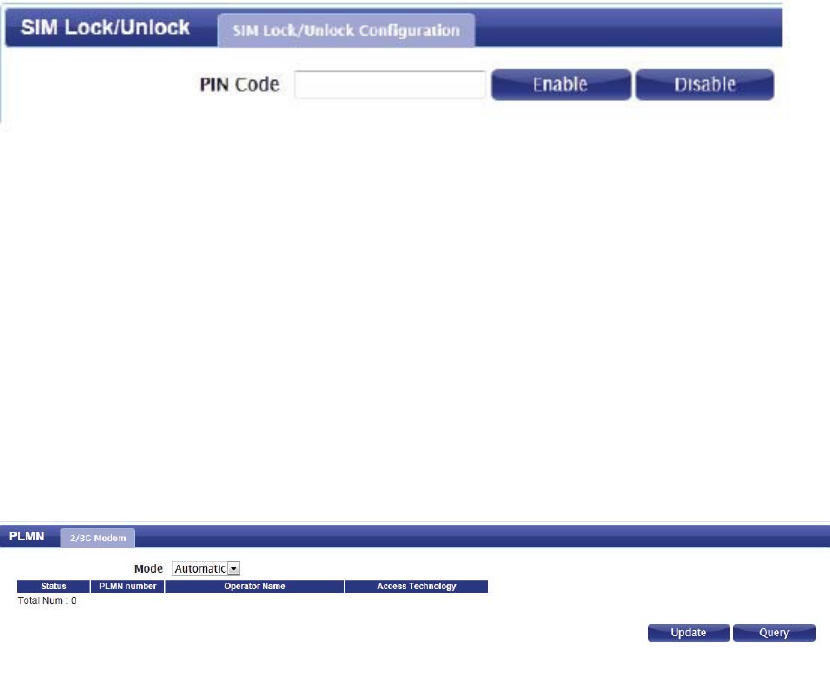
Auto - The modem will automatically select the modem type depending on the
network it is connected to.
3G Only - The modem will only connect to 3G networks.
2G Only - The modem will only connect to 2G networks.
If you wish to change the modem type, select your new modem type and click
Change to effect the change. Re-enter the new PIN code.
Click Apply to apply the changes.
SIM
This section allows you to turn SIM lock on or off for the SIM card which is
currently inserted into the router.
PIN Code: Enter the PIN code for the SIM card. Click Enable to turn on SIM
lock, or click Disable to turn off SIM lock.
PLMN
This page allows you to view available Public Land Mobile Networks (PLMN).
This page can also be used to select a preferred network when you are
roaming outside of your home network.
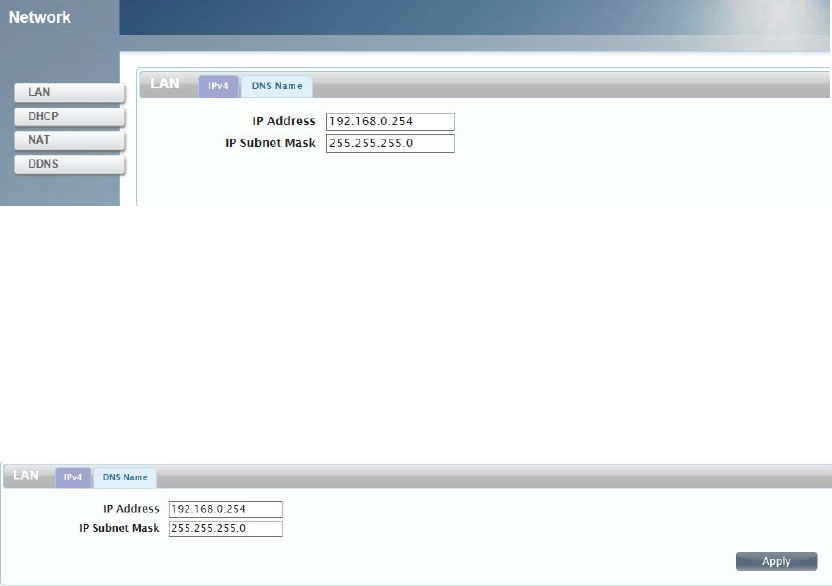
Mode: Select Automatic to allow the router to automatically connect to the
first available network when roaming. Select Manual to choose your preferred
roaming network from the list below.
If you have selected Manual mode, click on the preferred network to select it,
and then click the Update button to select that network as the preferred
network. Click Query to refresh the list of available networks.
Note: You will need to manually disconnect the current mobile data service
before selecting a network using PLMN.
Network
The Network pages allow you to check the current status of your Local Area
Network (LAN), and make changes to LAN Settings settings.
LAN
IPv4
IP Address:Enter the IPv4 address for your Wi-Fi network. If you change this
address, you will need to enter the new address in your web browser’s address
bar in order to access the web-based configuration utility.
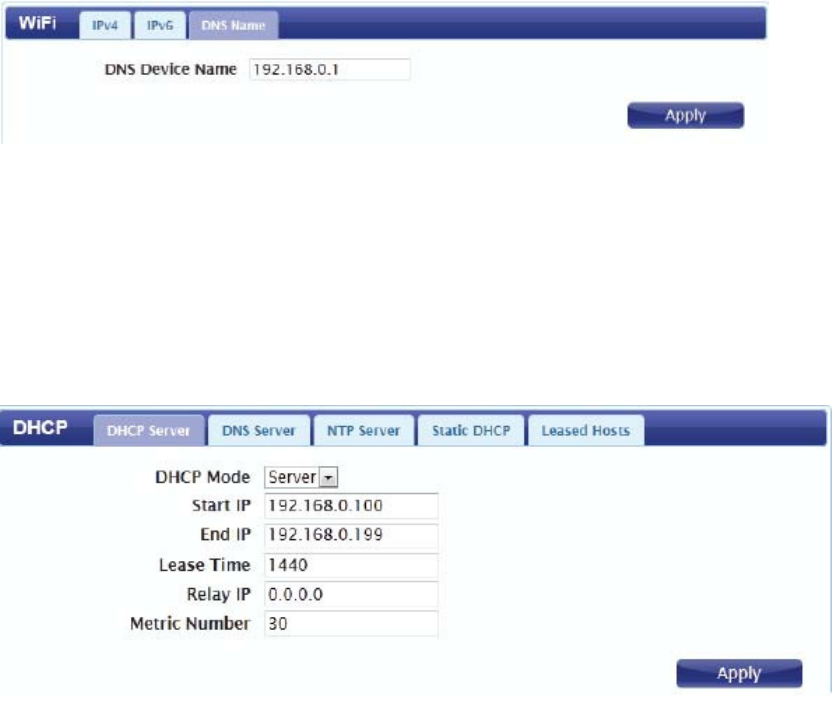
IP Subnet Mask:Enter the IPv4 subnet mask for your Wi-Fi network.
DNS Name
DNS Device Name: Enter your router’s DNS device name in the field provided.
DHCP
DHCP Server
DHCP Mode: Select the desired DHCP mode from the drop down menu:
None - Turns off DHCP functionality
Server - The router will act as a DHCP server and assign IP addresses to
connected devices.
Relay - The router will act as a relay between DHCP clients and a DHCP
server on another subnet.
Start IP: Enter the starting address for the DHCP pool.
End IP: Enter the ending address for the DHCP pool.
Lease Time: Enter the lease time (in minutes) for assigned IP addresses.
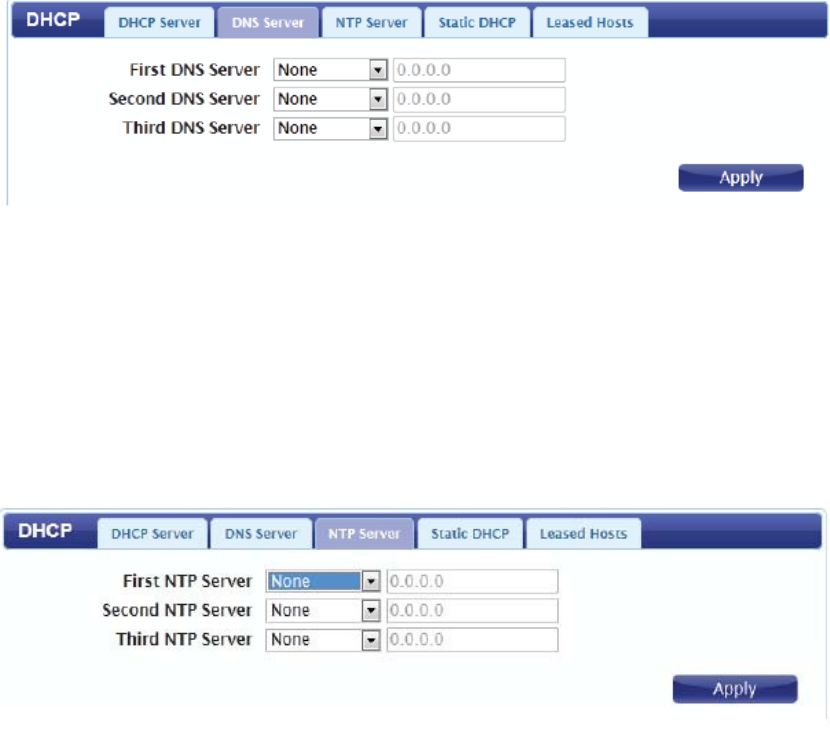
Relay IP: If you selected Relay above, enter the IP address of the DHCP
server to be relayed.
Metric Number: Enter the metric number to be used for the DHCP server.
DNS Server
First/Second/Third DNS Server: Select None from the drop-down menus if you
do not wish to specify a first, second, or third DNS server. Select User Define
to specify a DNS server, and enter the address of the server in the field
provided.
NTP Server
First/Second/Third NTPServer: Select None from the drop-down menus if you
do not wish to specify a first, second, or third Network Time Protocol server.
Select From ISP to use the automatic settings supplied by your ISP, or select
User Define to specify an NTP server, and enter the address of the server in
the field provided.
Static DHCP
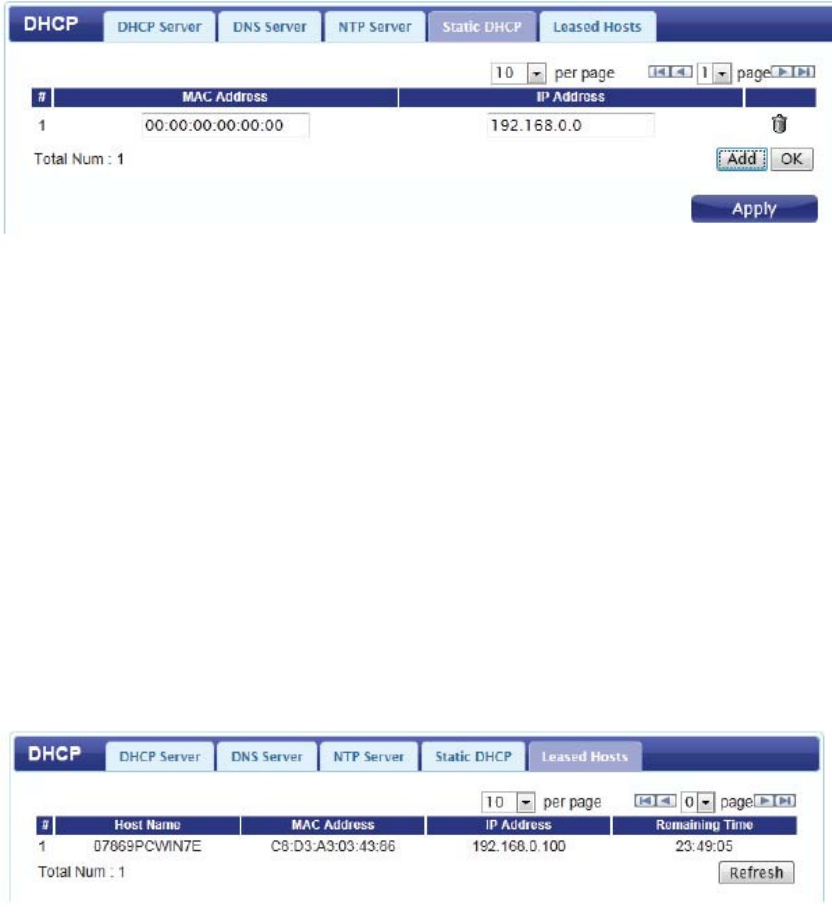
Use this option to specify a DHCP address reservation to a particular device or
machine based on MAC address. To add a new reservation, click Add.
MAC Address: Enter the MAC address of the device or machine for which you
wish to make the DHCP reservation.
IP Address: Enter the IP address that you wish to reserve. This address must
be within the DHCP address pool.
Click OK to save the reservation.
Leased Hosts
This table shows the details of clients currently receiving a DHCP address
from the DHCP server. Click Refresh to update the table.
NAT
This section allows you to configure functions related to Network Address
Translation (NAT) such as port triggering, and the Demilitarized Zone (DMZ)
Port Trigger
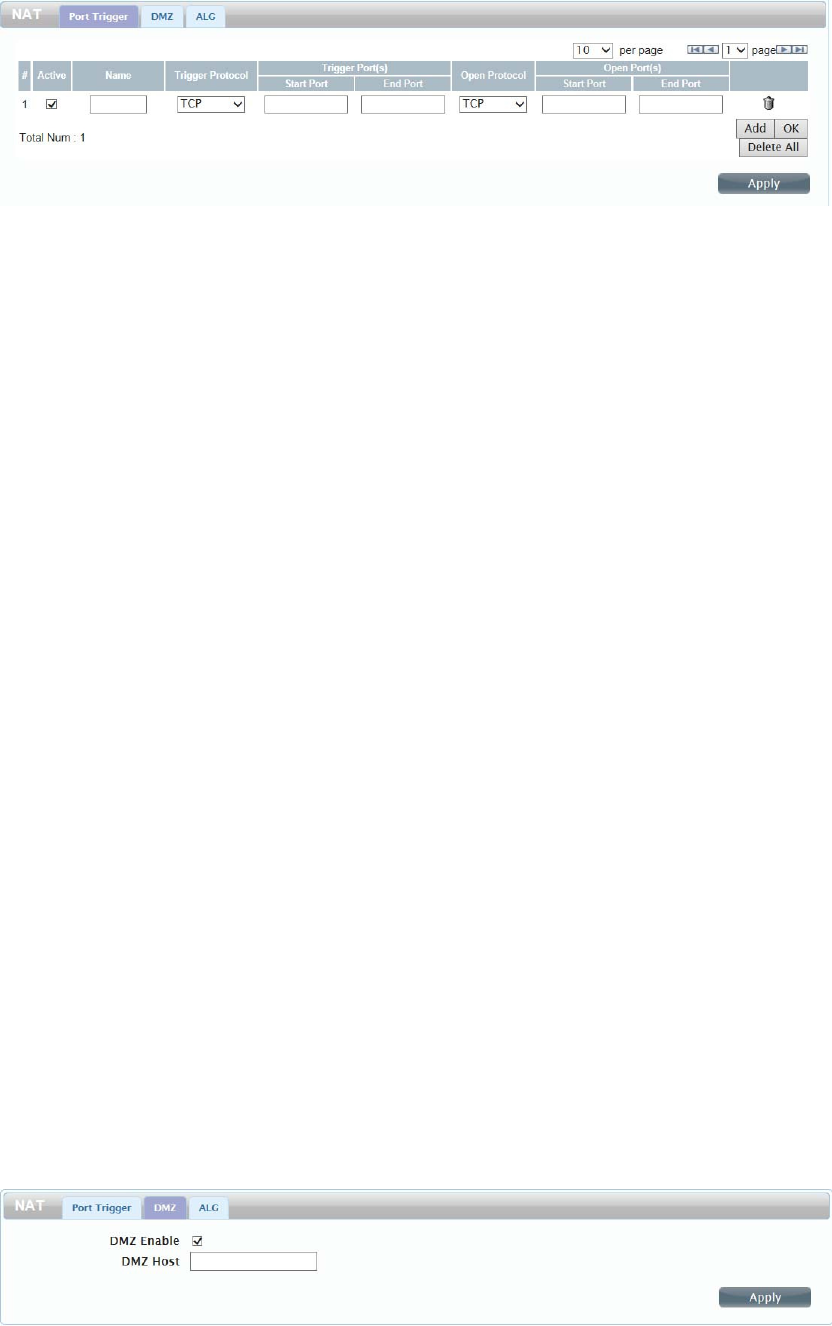
Use this option to have inbound traffic automatically forwarded to a dynamic
address on the LAN when triggered by outbound traffic. To add a new port
triggering rule, click Add.
Active: Check the box to activate this rule.
Name: Specify a name to identify the rule.
Trigger Protocol: Select TCP or UDP as the protocol for the trigger ports from
the drop-down menu.
Trigger Port: Enter the starting and ending trigger port for the rule.
Open Protocol: Select TCP or UDP as the protocol for the ports to be opened
from the drop-down menu.
Open Port(s): Enter the starting and ending ports to be opened when the
trigger occurs.
Delete: Click the Delete icon to delete the rule.
Click OK to save the rule. Click Apply to apply the current rules and return to
the Network page.
DMZ
If a machine on your network is having trouble running an application from
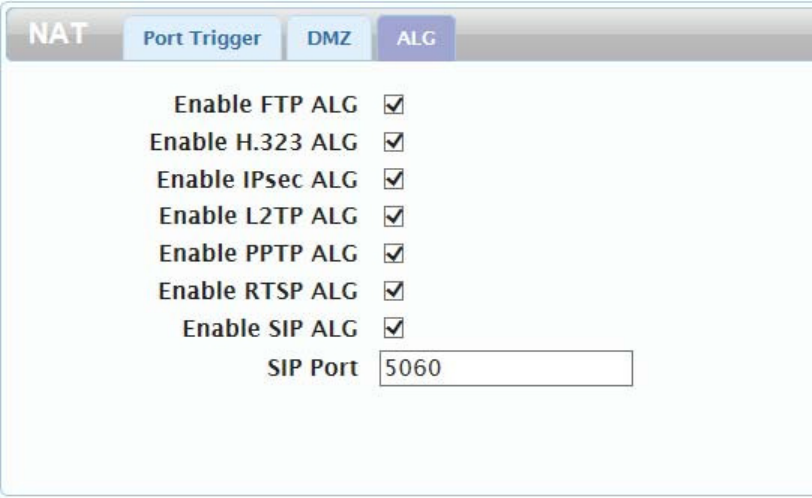
behind the router’s firewall, you can choose to enable the DMZ, which will
expose the selected machine completely to the Internet. It is recommended
that this is only used as a last resort, and that you understand the security
implications before enabling the DMZ.
DMZ Enable: Check the box to enable the DMZ function.
DMZ Host: Enter the IP address of the machine that you wish to place in the
DMZ. If this machine receives an IP address from the DHCP server, you
should make a DHCP reservation to ensure that the machine always receives
the same IP address.
Click Apply to save the settings and return to the Network page.
ALG
Application Level Gateways (ALG) allow certain applications to augment a
network’s firewall or NAT. This section enables you to enable various ALGs as
required by specific applications. To enable an ALG, check the box next to the
name of the rule.
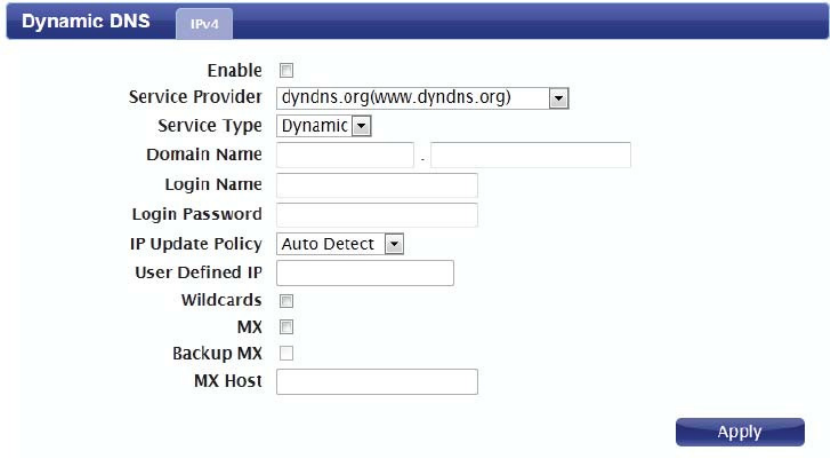
SIP Port: Enter the Session Initiation Protocol (SIP) port required by your
applications.
Click Apply to save the settings and return to the Network page.
DDNS
The DDNS feature allows you to host a server (web, FTP, game server, etc.)
using a domain name that you have purchased (www. yourdomain.com) with
your dynamically assigned IP address. Most broadband Internet service
providers assign dynamic (changing) IP addresses. Using a DDNS service
provider, users can enter in your domain name to connect to your server
regardless of your IP address.
Enable: Check the box to enable the NAT64 function.
Service Provider : Select your DDNS service provider from the drop-down
menu.
Service type: Select the DDNS service type from the drop-down menu.
Domain Name: Enter the domain name for your DDNS service.
Login Name: Enter the username associated with your DDNS account.
Login Password: Enter the password for your DDNS account.
IP Update Policy :Select the preferred IP update policy from the drop-down
menu.
User Defined IP: If you selected User Defined above, enter the IP address for
updates.
Wildcards: If your service provider supports wildcards, you can enable this
option to have wildcard addresses associated with your host domain.
MX: Check this box to enable mail exchange (MX) for your DDNS domain.
Service
Backup MX: Check this box to enable the backup MX for your DDNS domain.
MX Host: Enter the host name for your MX service.
SMS
The DWR-810 can send a receive SMS text messages through the mobile
network’s SMS function. In this section you can check the SIM card’s inbox
and outbox, as well as send new messages.
New Message
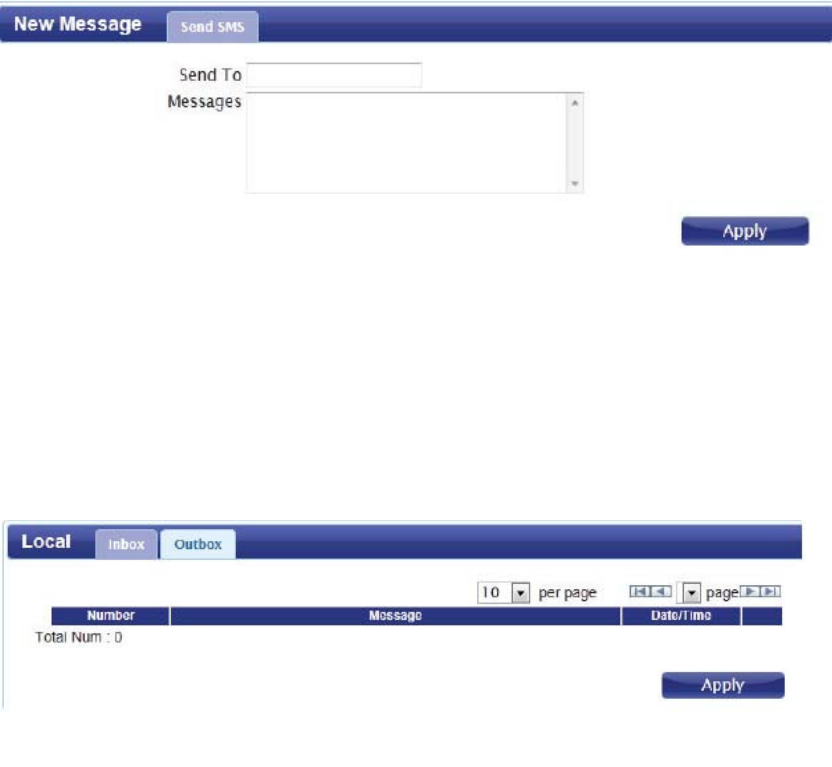
Send To: Enter the phone number that you wish to send the message to
Messages: Enter the body of the message to be sent.
Local
Inbox
This tab shows a summary of SMS messages in the inbox.
Outbox
This tab shows a summary of messages in the outbox which are yet to be sent.
Wi-Fi
The Wi-Fi pages allow you to check the current status of your Wi-Fi
network, and make changes to Wi-Fi settings.
Basic
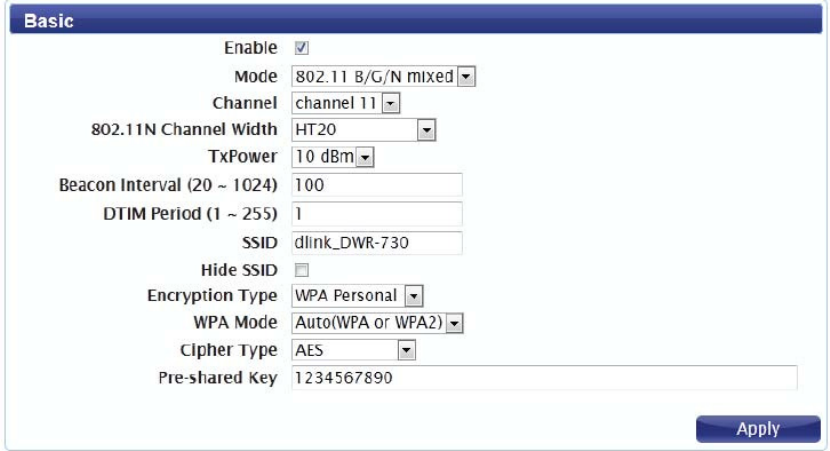
This section allows you to configure your Wi-Fi network and specify the
wireless security method to be used to secure your network.
Enable: Check the box to enable to Wi-Fi function.
Mode: Select the desired 802.11 wireless mode from the dropdown menu. You
should make your selection based on the standards supported by the wireless
clients which will be connecting to your network.
Channel: To have the router automatically select the optimal wireless channel,
select Auto from the drop-down menu. If you wish to select a particular channel,
select if from the drop-down menu.
802.11N Channel Width: If you are using the 802.11n standard, you can
manually select the channel width which best suits your network environment.
Beacon Interval: The beacon interval determines how often information about
the wireless network is broadcast. It is recommended that you do not adjust
this setting unless instructed to do so.
DTIM Period: The Delivery Traffic Indication Message broadcasts information
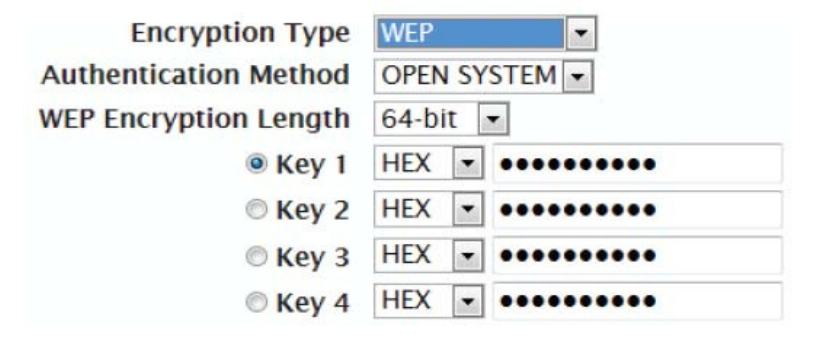
about buffered data to clients that are currently in low-power mode. Enter the
desired DTIM period as a number of beacon intervals.
SSID: Enter the SSID (network name) to identify your wireless network.
Hide SSID: Check the box to hide the SSID of your network. If the SSID is
hidden, wireless clients must manually enter it in order to connect to your
network.
Encryption Type: Select the wireless encryption method that you wish to use
from the drop-down menu. If you do not wish to enable wireless security, select
None from the drop-down menu. Click Apply to save the current settings.
Wireless Security
It is recommended that you enable wireless security on your router in order to
protect your wireless network from unauthorized access. You should select a
wireless security protocol that is compatible with the wireless clients which will
be accessing your network.
Wired Equivalent Privacy (WEP)
Wired Equivalent Privacy (WEP) is an older wireless security standard, which
although providing more protection than no security at all, has some
weaknesses which could make it vulnerable to intrusion. It is recommended
that you only use WEP if your wireless clients do not support Wi-Fi Protected
Access (WPA). WEP is not supported by the 802.11n standard, and therefore
you will not be able to achieve 802.11n speeds if using WEP.
Encryption Type: Select WEP from the drop-down menu.
Authentication Method: Select the desired authentication method from the
dropdown menu:
Auto - The router will automatically determine the authentication method based
on the client that is connecting to it.
Open System - Clients do not require authentication in order to associate with
the router. The encryption key will be used to encrypt data packets sent over
the network.
Shared - The encryption key is used for authentication as well as to encrypt
data packets.
WEP Encryption Length: Select the length of the encryption key to be used.
64-bit - A 64-bit key comprises a string of 10 hexadecimal characters, or 5
ASCII characters.
128-bit - A 128-bit key comprises a string of 26 hexadecimal characters, or 13
ASCII characters.
Key 1-4: You can predetermine up to 4 WEP keys. Select the WEP key you

wish to use by clicking on the radio buttons next to the keys. Select whether
you wish to use HEX or ASCII characters in your key using the drop-down
menu. Enter the desired key in the field provided. Click Apply to save the
current settings.
Wi-Fi Protected Access (WPA)
Wi-Fi Protected Access (WPA) is a newer and more secure encryption
protocol which makes significant improvements over WEP. There are two
versions of WPA; the original WPA, and the newer WPA2.
Encryption Type: Select WPA Personal from the drop-down menu.
WPA Mode: Select the desired authentication method from the dropdown
menu:
Auto (WPA or WPA2) - The router will automatically determine the version of
WPA to be used based on the client that is connecting to it.
WPA - Clients will only be able to associate with the router using the WPA
standard.
WPA2 - Clients will only be able to associate with the router using the WPA2
standard. Clients which do not support WPA2 will not be able to associate with

the router.
Cipher Type: Select the desired cipher type from the drop-down menu:
TKIP - This cipher is used by the WPA standard.
AES - A newer cipher used by the WPA2 standard. Use of this cipher type is
required in order to achieve 802.11 speeds.
Pre-Shared Key: The pre-shared key is the password which clients will require
in order to connect to your network. Enter a password of between 8 and 63
characters in length.
Click Apply to save the current settings
WLAN Authentication and Privacy
Infrastructure (WAPI)
WLAN Authentication and Privacy Infrastructure (WAPI) is a wireless security
standard which is implemented in China. You should only use this protocol if
your wireless clients do not support any of the other security methods provided
by the DWR-810.
Encryption Type: Select WAPI Personal from the drop-down menu.
WAPI Pre-Shared Key: Select whether your key should use ASCII or HEX

characters using the drop down menu. Enter your desired key in the field
provided.
Click Apply to save the current settings.
Wi-Fi Protected Setup (WPS)
Wi-Fi Protected Setup (WPS) enables you to quickly and securely add
compatible devices to your wireless network.
Enable: Check the box to enable the Wi-Fi Protected Setup feature.
Configure State: Shows the current status of the WPS function.
Configure Method: Select the WPS method that you wish to use. If your device
supports Push Button Connection (PBC), simply select this option and click
Apply to start the connection process. You will then have 120 seconds to press
the WPS button on your wireless device in order to initiate the connection. If
your device does not support PBC, you can select the PIN method and
continue to the next step.
Current PIN: A PIN is a unique number that can be used to add the router to an
existing network or to create a new network.
Generate PIN: For extra security, a new PIN can be generated. Click Generate

to create a new PIN. The current PIN will be shown in the field next to Current
PIN. This PIN can be used by wireless clients to join your network using the
PIN method
Enrollee PIN: If the device you are trying to add to the network was provided
with a PIN number, select this option and enter the device’s PIN in the field.
Click Apply to commence the connection process.
MAC Filter
The MAC filtering option allows you to allow or deny access to wireless clients
based on their MAC address.
Enable MAC Address Filter: Check the box to enable the MAC filtering feature
Mode: Select the filtering mode from the drop-down menu. You can choose to
Deny Listed Stations access to your network, or Allow Listed Stations access.
Listed Stations Table
To add a new filtering rule, click Add.
Active: Check the box to activate the rule.
Name: Enter a name to identify the machine or station which will be filtered.
MAC Address: Enter the MAC address of the machine or station which you
wish to filter
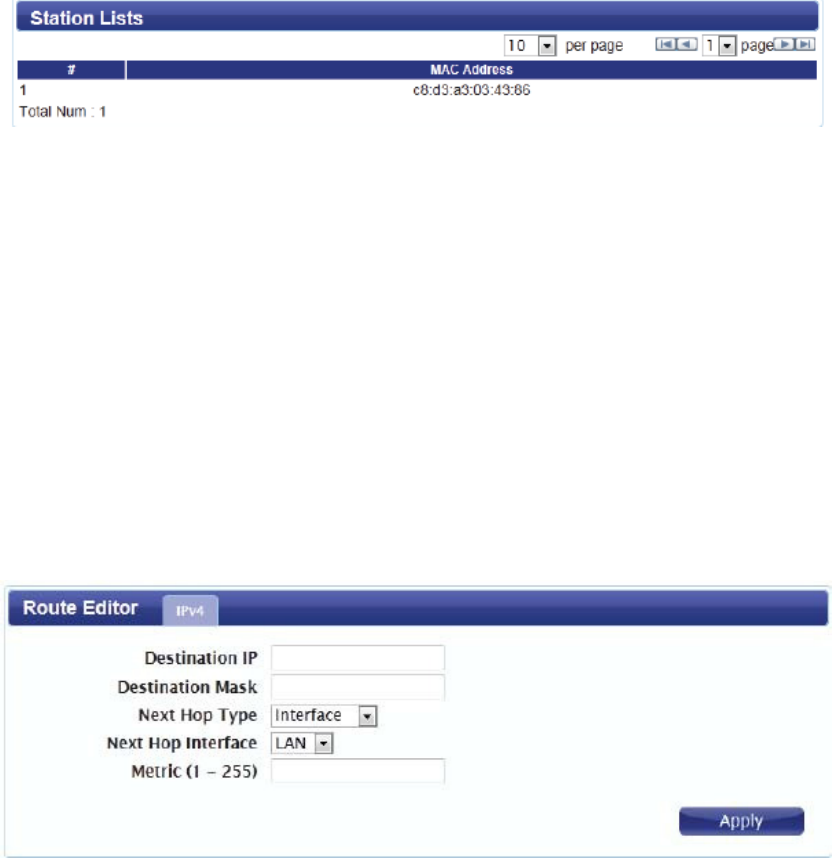
Delete: Click the Delete icon to delete the rule from the table.
Click OK to save the current rule and add it to the table. Click Apply to save all
changes and return to the Wi-Fi page.
Station List
The Station List tab shows a list of all wireless clients currently connected to
your wireless network.
Advanced
Static Route
The Static Route feature allows you to customize specific routes for data
through your network
IPv4
The IPv4 routing table lists all current routing rules. Click Add to add a new
routing rule.

De
s
De
s
Ne
x
dro
Ne
x
the
Me
t
bet
w
Cli
c
R
Th
e
fro
m
set
t
Set
t
En
a
set
t
LA
N
s
tination I
P
s
tination
M
x
t Hop Ty
p
p-down m
e
x
t Hop Int
e
drop-dow
n
t
ric: The
m
w
een 1 a
n
c
k Apply t
o
IP
e
Routing I
m
being pr
o
t
ings.
t
ing
a
ble: Che
c
t
ings.
N
P
: Enter th
e
M
ask: Ente
r
p
e: Select
I
e
nu.
e
rface: Sel
e
n
menu.
m
etric will
d
n
d 255 in t
h
o
save the
nformatio
n
o
pagated.
c
k the box
t
e
destinati
o
r
the desti
n
I
nterface
o
e
ct either
L
etermine
y
h
e field pr
o
routing rul
e
n
Protocol
Use this
s
t
o enable
R
on IP add
r
n
ation ma
s
o
r IP Addr
e
L
AN or W
A
y
our route
o
vided.
e.
(RIP) use
s
s
ection to
c
R
IP. The t
a
r
ess for yo
s
k for your
e
ss as the
A
N as the
n
selection
p
s
metrics t
o
c
onfigure
y
a
ble will s
h
u
r route.
route.
h
op type f
r
n
ext hop i
n
p
rocess. E
o
prevent
r
y
our route
r
’
h
ow detail
s
r
om the
n
terface fr
o
E
nte
r
a me
t
r
outing lo
o
’s RIP
s
o
f
your
R
o
m
t
ric
o
ps
R
IP
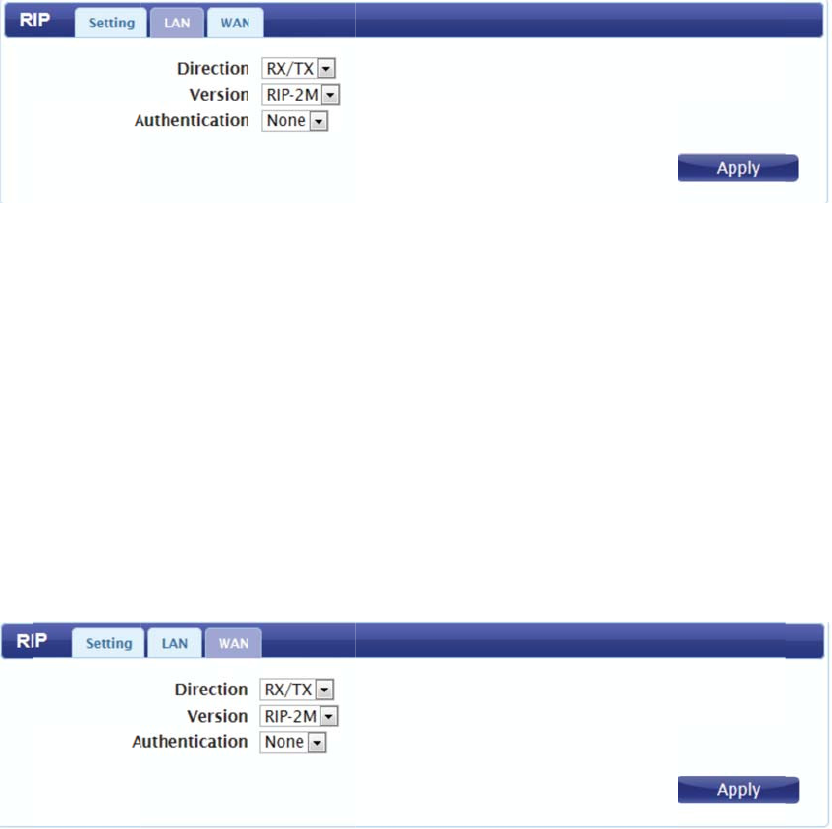
Dir
e
ap
p
TX
Ve
r
A
u
t
me
n
W
A
Dir
e
ap
p
TX
Ve
r
Au
t
me
n
Cli
c
e
ction: Sel
p
ly RIP in
b
for outbo
u
r
sion: Sele
t
henticatio
n
nu.
A
N
e
ction: Sel
p
ly RIP in
b
for outbo
u
r
sion: Sele
t
henticatio
n
nu.
c
k Apply t
o
ect the de
s
b
oth inbou
n
u
nd only.
ct the RIP
n
: Select t
h
ect the de
s
b
oth inbou
n
u
nd only.
ct the RIP
n
: Select t
h
o
save the
s
ired dire
c
n
d and ou
t
version th
h
e desired
s
ired dire
c
n
d and ou
t
version th
h
e desired
current co
n
S
e
c
tion in whi
t
bound dir
e
at you wis
authentic
a
c
tion in whi
t
bound dir
e
at you wis
authentic
a
nfiguratio
n
e
cur
ch to appl
y
e
ctions, R
X
h to use fr
a
tion type
ch to appl
y
e
ctions, R
X
h to use fr
a
tion type
n
ity
y
RIP. Sel
e
X
for inbo
u
o
m the dr
o
f
rom the d
y
RIP. Sel
e
X
for inbo
u
o
m the dr
o
f
rom the d
e
ct RX/ T
X
u
nd only,
a
o
pdown m
e
rop-down
e
ct RX/ T
X
u
nd only,
a
o
pdown m
e
rop-down
X
to
a
nd
e
nu.
X
to
a
nd
e
nu.

The Security tab allows you to configure your router’s firewall settings and
enable features to protect your network from outside intrusions and malicious
attacks.
Firewall
IP Filter
Active: Check the box to active the IP filter rule.
Source IP: Enter the source IP address to be filtered.
Source From Port: Enter the starting port on the source IP.
Source To Port: Enter the ending port on the source IP.
Destination IP: Enter the destination IP address to be filtered.
Destination From Port: Enter the starting port of the destination IP.
Destination To Port: Enter the ending port of the destination IP.
Protocol: Select the protocol for the IP filter rule.
Delete: Click the icon to delete the IP filtering rule.
MAC Filter

The MAC filter allows you to allow or deny access to your wireless network
based on a client’s MAC address.
Blacklist/Whitelist: Select Blacklist to deny access to only the MAC addresses
listed below. Select Whitelist to allow access to only the MAC addresses listed
below.
Active: Check the box to activate the MAC filter rule.
Source MAC: Enter the MAC address of the machine or device which you wish
to filter packets coming from.
Destination MAC: Enter the MAC address of the machine you wish to filter
packets going to.
Day: Check the box for each day that you wish to activate the MAC filtering
rule.
Start Time: Enter the starting time at which you wish to activate the MAC
filtering rule each day.
End Time: Enter the ending time at which you wish to deactivate the MAC
filtering rule each day.
Delete: Click the icon to delete this MAC filtering rule.
Click Add to add the current rule to the rules list.
DDOS
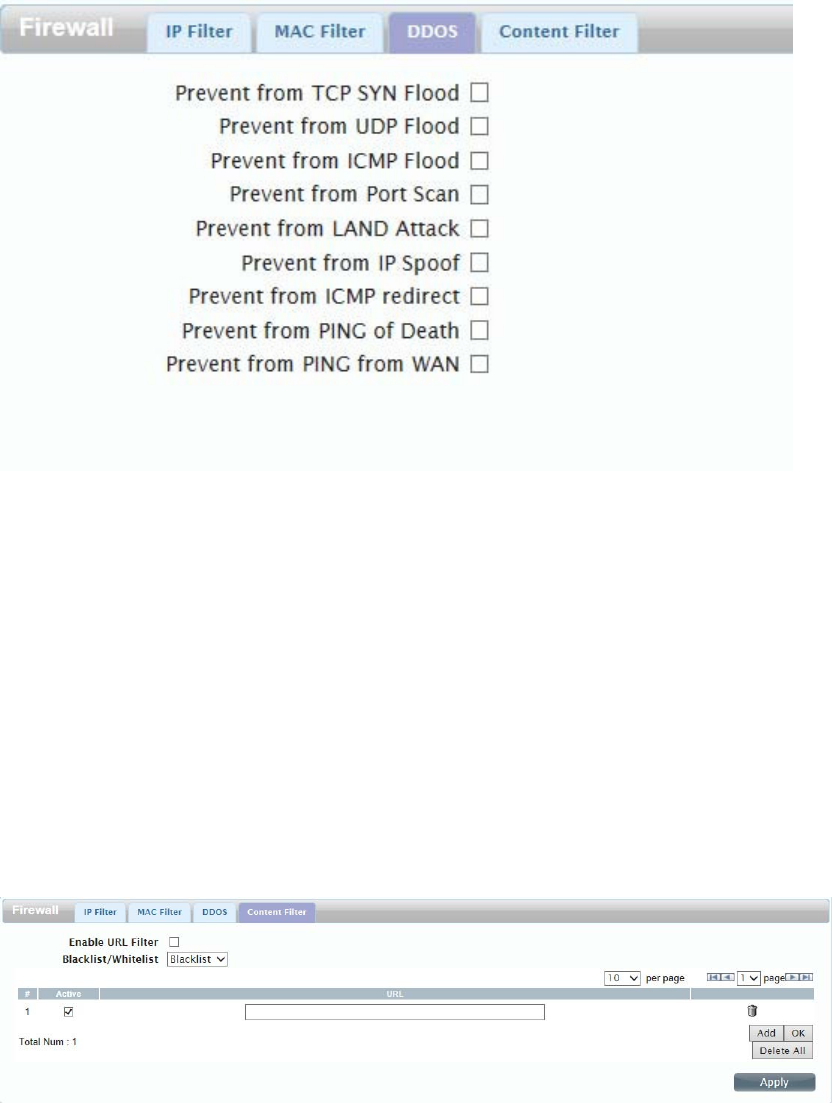
This section allows you to enable various security features to protect against
Denial of Service (DoS) attacks.
DoS Prevention Filters: Check the box next to the rule to enable prevention
against that specific kind of DoS attack.
Click Apply to save the current configuration
Content Filter
The content filter allows you to allow or deny access to specific URLs.
Enable URL Filter: Check the box to enable URL filtering.
Blacklist/Whitelist: Select Blacklist to deny access to only URLs listed in the
rule table. Select Whitelist to allow access to only URLs listed in the rule list.
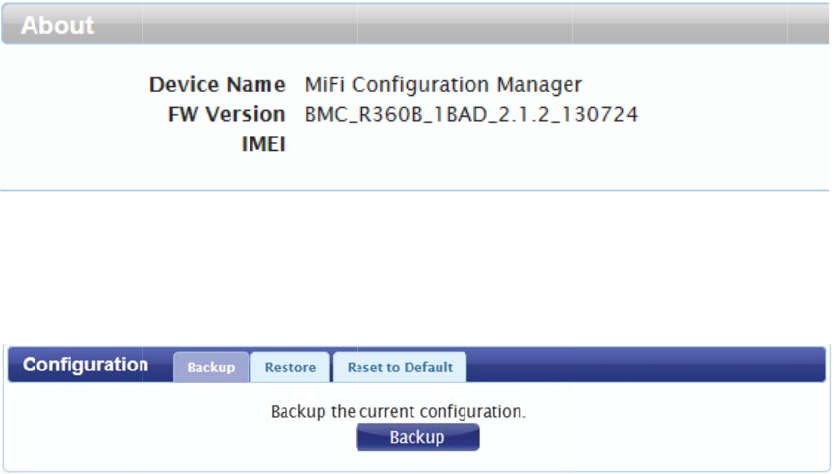
A
ct
UR
do
m
Del
Cli
c
Thi
s
tim
e
A
Thi
s
C
Ba
c
Cli
c
co
m
ca
n
ive: Chec
k
L: Enter t
h
m
ain nam
e
ete: Click
t
c
k Add to
s
s
tab allo
w
e
& date,
r
bout
s
tab sho
w
onfig
u
c
kup
c
k Backup
m
puter. Yo
n
choose
w
k
the box t
o
h
e URL th
a
e
, all URLs
t
he icon t
o
s
ave the r
u
w
s you to c
r
emote ac
c
w
s the rout
e
u
rati
o
to save th
u will be t
h
w
here to s
a
o
activate
t
a
t you wis
h
under thi
s
o
delete th
e
u
le and ad
d
S
y
o
nfigure t
h
c
ess, firm
w
er
’s basic
i
o
n
e route
r
’s
c
h
en be pro
m
a
ve the co
n
t
he URL fi
l
h
to allow
o
s
domain
w
e
rule.
d
it to the
r
y
ste
h
e route
r
’s
w
are, and
a
informatio
n
current co
n
m
pted wit
h
n
figuration
l
tering rul
e
o
r deny ac
c
w
ill be allo
w
r
ule table.
m
administr
a
a
ccess the
n
.
n
figuratio
n
h
a save
f
file.
.
c
ess to. If
y
w
ed or de
n
a
tive functi
system lo
g
n
to a file o
n
f
ile dialog
y
ou enter
a
n
ied acces
s
i
ons, such
g.
n your
ue, where
a
s
.
as
you
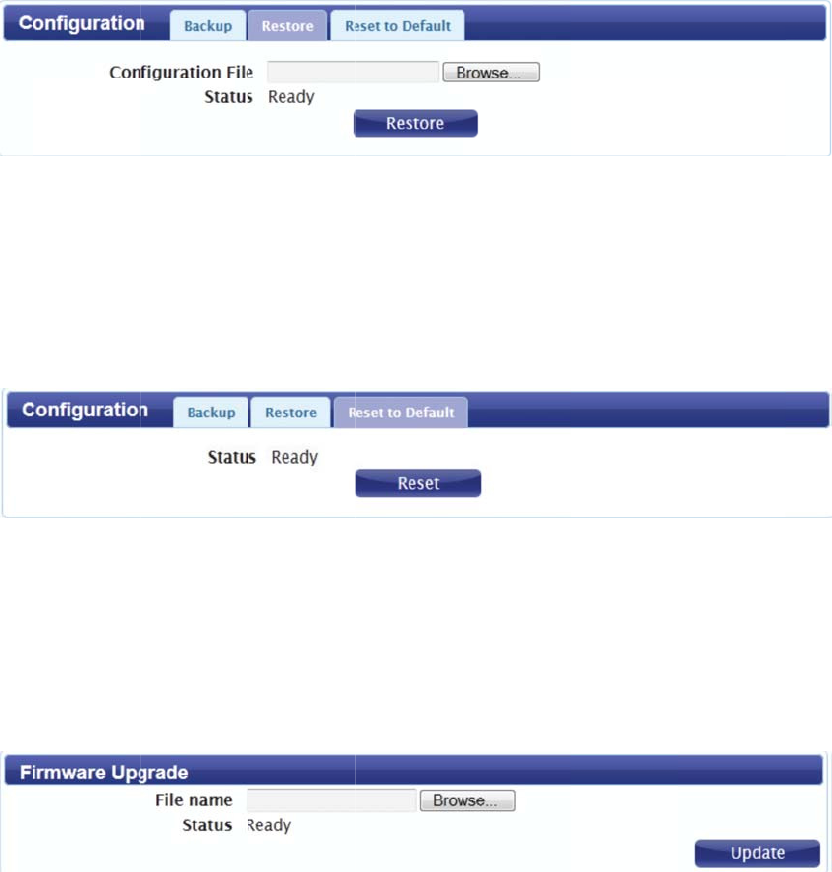
Re
s
Cli
c
On
c
to t
h
Re
s
Cli
c
Im
p
F
i
Yo
u
yo
u
Cl
co
m
fir
m
Im
p
a fi
r
s
tore
c
k Browse
c
e you ha
v
he selecte
s
et to Default
c
k Reset t
o
p
ortant:
A
ll
i
rmw
a
u
can upg
r
u
want to u
ick Brows
e
m
puter. O
n
m
ware upg
r
p
ortant:
A
ll
r
mware u
p
to locate
a
v
e located
d configur
a
o
restore t
h
settings s
a
re U
r
ade the fir
se is on t
h
e
to locate
n
ce the file
r
ade proc
e
current s
e
p
grade.
a
previousl
the file, cli
a
tion file.
h
e route
r
’s
t
ored on t
h
pgra
d
mware of
t
h
e local ha
r
a previou
s
has been
e
ss.
e
ttings will
l
y saved c
o
i
ck Restor
e
settings t
o
h
e router
w
d
e
t
he router
r
d drive of
s
ly downl
o
located, c
be restor
e
o
nfiguratio
e
to config
o
the facto
w
ill be lost
f
here. Mak
e
the comp
u
aded firm
w
l
ick Updat
e
e
d to their
f
n file on y
o
u
re the ro
u
r
y defaults
f
ollowing
a
e
sure the
u
ter.
w
are file o
n
e
to carry
o
f
actory def
a
o
ur compu
u
ter accor
d
s
.
a
factory r
e
firmware
f
n
your
o
ut the
f
aults follo
w
ter.
d
ing
e
set.
f
ile
w
ing
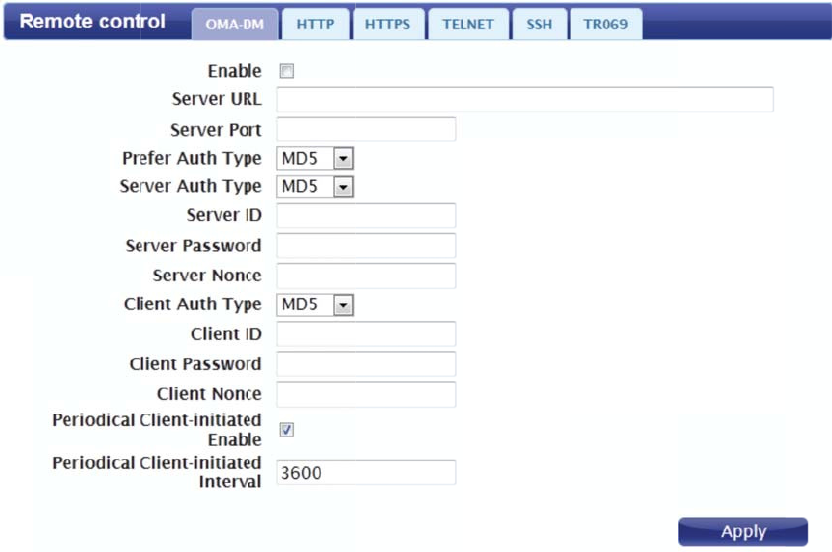
R
Thi
s
Wit
int
e
O
M
En
a
A
lli
a
Se
r
Se
r
Pr
e
me
n
Se
r
emot
s
section
a
h remote
m
e
rface rem
o
MA
-D
M
a
ble: Che
c
a
nce (OM
A
r
ver URL:
E
r
ver Port:
E
e
fer Auth T
nu.
r
ver Auth
T
e Co
n
a
llows you
m
anagem
e
o
tely usin
g
M
c
k the box
t
A
) Device
M
E
nter the
U
E
nter the
p
ype: Sele
c
T
ype: Sele
c
n
trol
to configu
r
e
nt, you c
a
g
any Inter
n
t
o enable
r
M
anagem
e
U
RL of the
p
ort for the
c
t your pre
f
c
t the ser
v
r
e your ro
u
a
n access
y
n
et conne
c
r
emote m
a
e
nt (DM)
p
server yo
u
server.
f
erred aut
h
v
e
r
’s authe
u
te
r
’s rem
o
y
our route
r
c
tion.
a
nagemen
t
p
rotocol.
u
will use
t
h
entication
ntication t
y
o
te manag
e
r
’s configu
r
t
using the
t
o manage
type from
y
pe from t
h
e
ment fea
t
ration
Open Mo
b
e
the devic
e
the dropd
h
e drop-d
o
t
ure.
b
ile
e
.
o
wn
o
wn

me
n
Se
r
Se
r
Se
r
co
m
Cli
e
me
n
Cli
e
Cli
e
Cli
e
co
m
Pe
r
Pe
r
H
T
HT
T
HT
T
HT
T
A
c
c
nu.
r
ver ID: E
n
r
ver Pass
w
r
ver Nonc
e
m
municati
o
e
nt Auth T
y
nu.
e
nt ID: Ent
e
e
nt Passw
o
e
nt Nonce:
m
municati
o
r
iodical Cli
e
r
iodical Cli
e
T
TP
T
P Serve
r
T
P protoc
o
T
P Server
c
ept Requ
e
n
ter the ID
w
ord: Ente
r
e
: Enter th
e
o
ns.
y
pe: Sele
c
e
r the clie
n
o
rd: Enter
Enter the
o
ns.
e
ntinititate
e
ntinitiate
d
Enable:
C
o
l.
Port: Ent
e
e
st From
W
o
f the ser
v
r
the pass
w
e
number
t
c
t the clien
t
n
t ID,
the client
p
number t
o
d
Enable:
d
Interval:
E
C
heck the
b
e
r the port
f
W
AN: Che
c
v
er.
w
ord for th
t
o be used
t
authentic
p
assword
o
be used
b
Check to
e
E
nter the i
b
ox to ena
b
f
or the HT
T
c
k to enab
l
e server.
by the se
r
ation type
b
y the clie
n
e
nable cli
e
nterval pe
r
b
le remot
e
T
P server.
l
e WAN re
r
ver as the
from the
d
n
t as the n
nt initiatio
n
r
iod for cli
e
e
manage
m
q
uest acc
e
e
nonce fo
r
d
rop-down
n
once fo
r
n
.
e
nt initiati
o
m
ent using
e
ptance.
r
n.
the
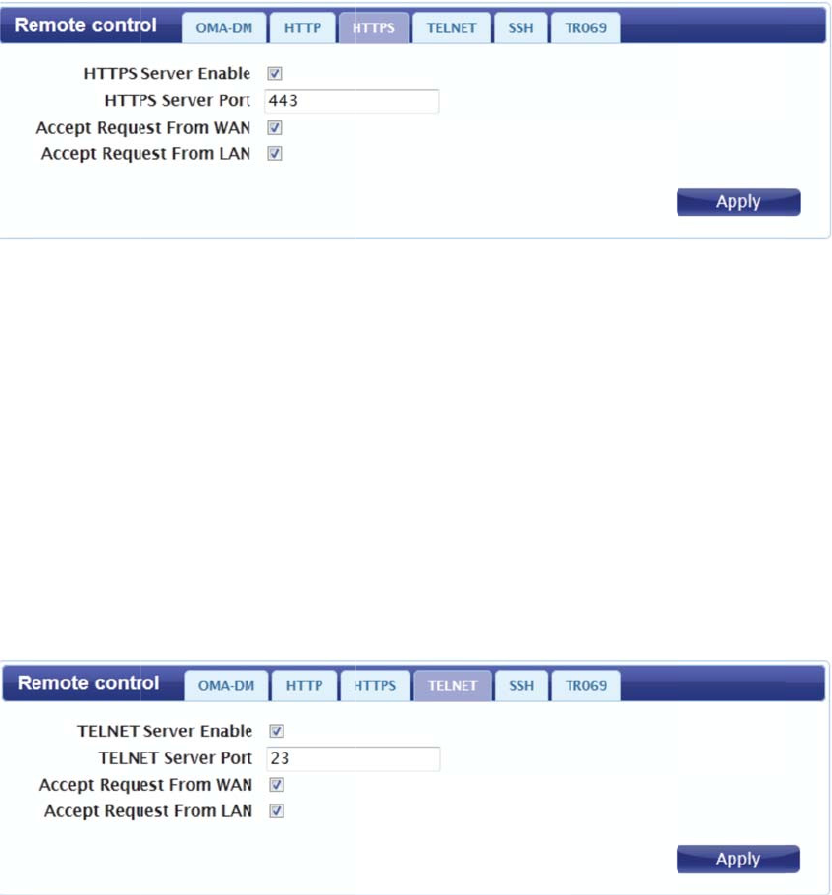
H
T
HT
T
the
HT
T
A
c
c
A
c
c
T
E
TE
L
the
TE
L
A
c
c
A
c
c
S
S
T
TPS
T
PS Serv
e
HTTPS p
r
T
PS Serv
e
c
ept Requ
e
c
ept Requ
e
E
LNE
T
L
NET Ser
v
TELNET
p
L
NET Ser
v
c
ept Requ
e
c
ept Requ
e
S
H
er
Enable:
r
otocol.
er
Port: En
t
e
st From
W
e
st From
L
T
v
e
r
Enable
p
rotocol
v
e
r
Port: E
e
st From
W
e
st From
L
Check the
t
er the po
r
W
AN: Che
c
L
AN: Chec
k
: Check th
nter the T
E
W
AN: Che
c
L
AN: Chec
k
e
box to en
r
t for the H
c
k to enab
l
k
to enabl
e
h
e box to e
E
LNET se
r
c
k to enab
l
k
to enabl
e
able remo
t
T
TPS ser
v
l
e WAN re
e
LAN req
u
nable rem
o
r
ver port.
l
e WAN re
e
LAN req
u
t
e manag
e
v
er.
q
uest acc
e
u
est acce
p
o
te mana
g
q
uest acc
e
u
est acce
p
e
ment usin
e
ptance.
p
tance
g
ement us
i
e
ptance.
p
tance.
g
ng
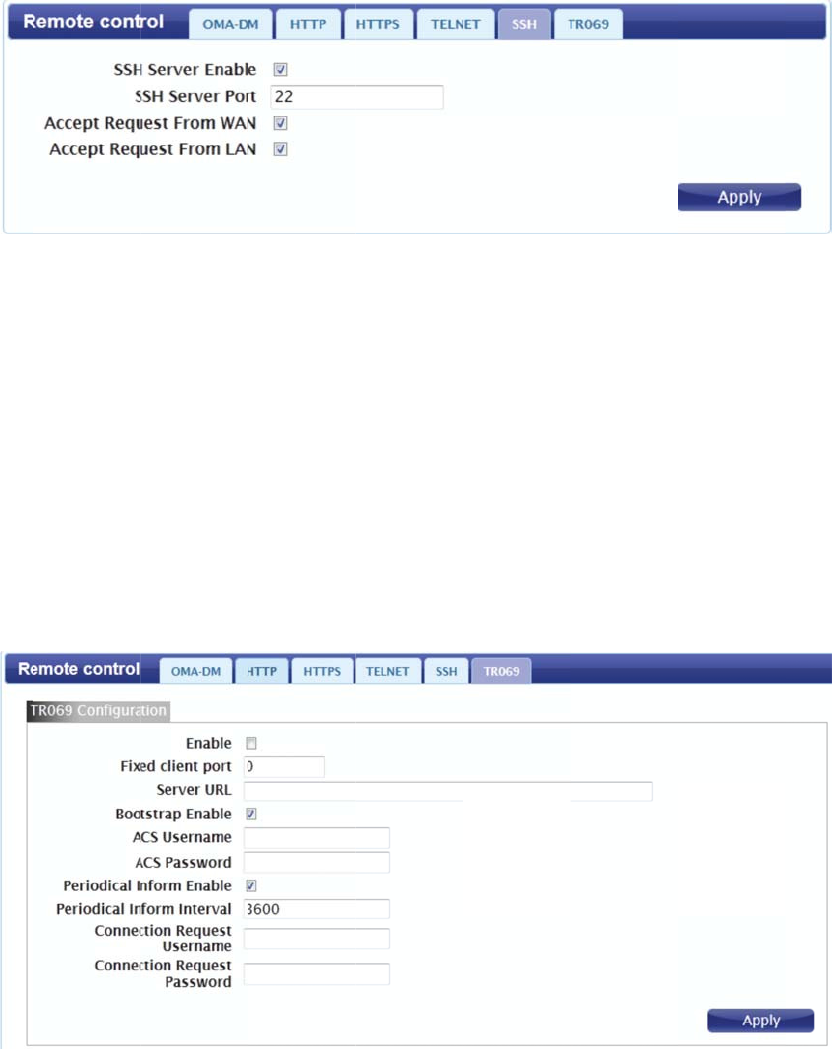
SS
H
Se
c
SS
H
A
c
c
A
c
c
T
R
En
a
usi
n
Fix
e
Se
r
Bo
o
H
Serve
r
E
c
ure Shell
H
Server
P
c
ept Requ
e
c
ept Requ
e
R
069
a
ble: Che
c
n
g the TR
-
e
d Client
P
r
ver URL:
E
o
tstrap En
a
E
nable: C
h
protocol.
P
ort: Enter
e
st From
W
e
st From
L
c
k the box
t
-
069 proto
c
P
ort: Enter
E
nter the
U
a
ble: Ena
b
h
eck the b
o
the SSH
s
W
AN: Che
c
L
AN: Chec
k
t
o enable
a
c
ol.
the fixed
p
U
RL for th
e
b
le the rou
t
o
x to enab
l
s
erver por
t
c
k to enab
l
k
to enabl
e
a
utomatic
p
ort for th
e
e
TR-069
s
t
er to act
a
l
e remote
m
t
.
l
e WAN re
e
LAN req
u
r
emote co
n
e
client de
v
s
erver to b
a
s a bootst
m
anagem
e
q
uest acc
e
u
est acce
p
n
figuration
v
ice.
e
used.
r
ap device
e
nt using t
e
ptance
p
tance
n
o
f
your r
o
e
.
h
e
o
uter

A
C
S
A
C
S
Pe
r
A
C
S
Pe
r
Co
n
Co
n
P
a
Thi
s
A
d
m
Sel
pa
s
Ol
d
Ne
w
Re
t
D
Thi
s
S
Userna
m
S
Passwo
r
r
iodical Inf
o
S
serve
r
t
o
r
iodical Inf
o
n
nection
R
n
nection
R
a
ssw
s
page let
s
m
inistrator
ect the us
e
s
sword for
d
Passwor
d
w
Passwo
r
t
ype New
P
ate a
s
page let
s
m
e: Enter
t
r
d: Enter t
h
o
rm Enabl
e
o
announc
e
o
rm Interv
a
R
equest U
s
R
equest P
a
ord
s
you cha
n
(Admin)
a
er
to chan
g
the admin
d
: Enter th
e
r
d: Enter t
h
P
assword:
nd Ti
s
you set t
h
t
he Auto C
h
e Auto C
o
e
: Check t
o
e
its prese
a
l: Enter t
h
s
ername:
E
a
ssword: E
n
ge the co
n
a
nd User a
c
g
e passw
o
or user a
c
e
existing
p
h
e new pa
s
Type the
n
me
h
e time an
onfigurati
o
o
nfiguratio
o
allow th
e
e
nce.
h
e interval
E
nter the u
E
nter the p
a
n
figuration
c
counts.
o
rd: Select
c
count fro
m
p
assword
f
s
sword fo
r
new pass
w
n
d date for
o
n Server
u
n Server
p
e
router to
for periodi
sername
f
a
ssword f
o
interface
p
whether y
m
the drop
f
or this ac
c
r
this acco
u
w
ord agai
n
your rout
e
u
sername.
p
assword.
send mes
s
cal inform
o
r connec
t
o
r connecti
p
assword
s
o
u wish to
down me
n
c
ount.
u
nt.
to confir
m
e
r, and als
o
s
ages to t
h
message
s
t
ion reque
s
on reques
s
for the
o
change t
h
n
u.
m
.
o
configur
e
h
e
s
.
s
ts.
t
s.
h
e
e
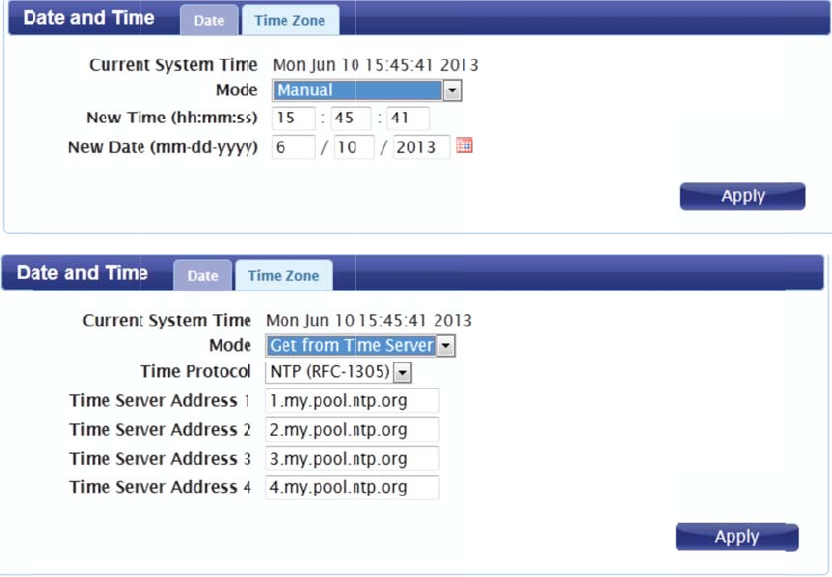
aut
o
Dat
e
Cu
r
rou
t
Mo
d
Ti
m
Ne
t
Ne
w
Ne
w
Ti
m
pro
t
Ti
m
us
e
o
matic tim
e
r
rent Syst
e
te
r
’s syste
d
e: Select
m
e Server
t
t
work Tim
e
w
Time: If
y
w
Date: If
y
m
e Protoco
tocol from
m
e Serve
r
A
e
d to sync
h
e synchro
n
e
m Time:
D
m clock.
Manual t
o
t
o have th
e
e
Protocol
y
ou select
y
ou select
e
l: If you s
e
the drop-
d
A
ddress 1
-
h
ronize th
e
n
ization a
n
D
isplays th
o
manually
e
router au
(NTP) ser
v
e
d Manua
l
e
d Manual
e
lected Ge
t
d
own men
u
-
4: Enter u
e
router’s
s
n
d dayligh
t
e current
t
set the ti
m
u
tomaticall
y
v
er.
l mode, e
n
l
mode, en
t
time Fro
m
u
.
p to four
N
s
ystem tim
e
t
savings ti
t
ime and d
a
m
e and dat
y
synchro
n
n
ter the cu
r
ter the cu
r
m
Server,
s
N
TP serve
r
e
and dat
e
me.
a
te accor
d
e, or sele
c
n
ize the ti
m
r
rent time.
r
rent date.
s
elect the
d
addresse
s
e
.
d
ing to the
c
t Get fro
m
m
e with a
d
esired ti
m
s
which wi
m
m
e
ll be
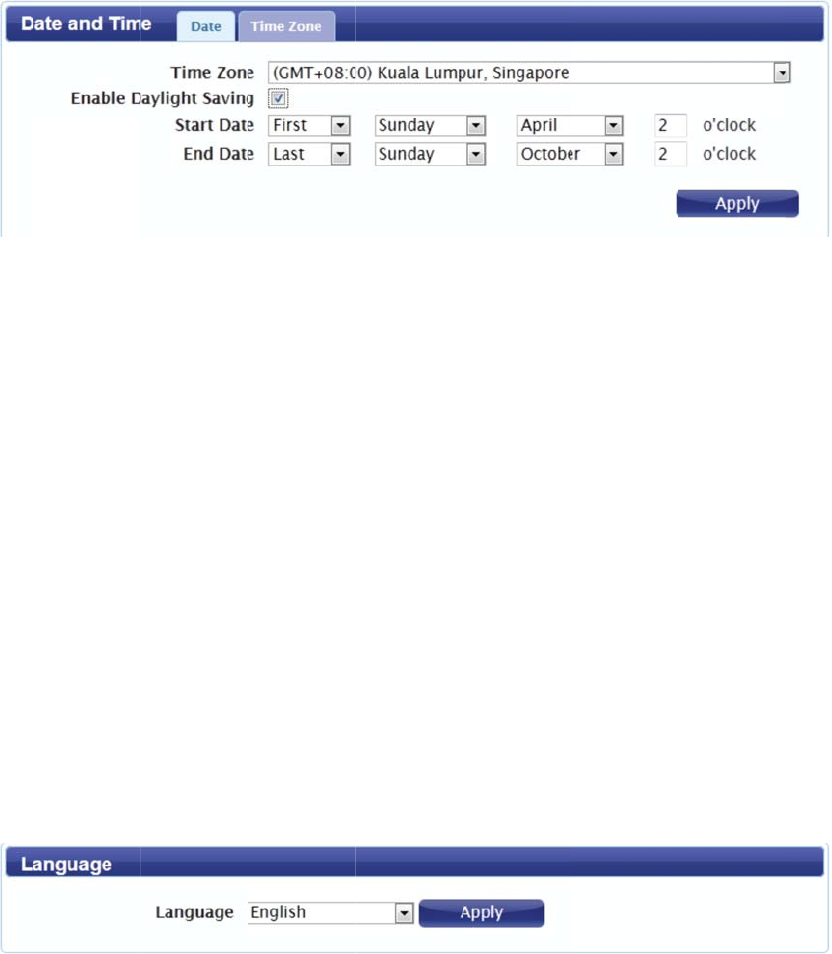
Cli
c
Tim
e
Ti
m
En
a
da
y
Sta
tim
e
En
d
in
y
Cli
c
L
a
La
n
Cli
c
S
y
Th
e
run
c
k Apply t
o
e Zone
m
e Zone:
S
a
ble Dayli
g
y
light savi
n
a
rt Date: E
n
e
in your r
e
d
Date: En
t
y
our regio
n
c
k Apply t
o
a
ngu
a
n
guage: S
e
c
k Apply t
o
y
ste
m
e
system l
o
ning.
o
save the
S
elect your
g
ht Saving
n
g.
n
ter the d
e
e
gion.
t
er the det
n
.
o
save the
a
ge
e
lect your
p
o
save the
m
Lo
g
o
g display
s
current se
t
time zone
:
Check th
e
e
tails of th
e
a
ils of the
current se
t
p
referred l
a
current co
n
s
a record
t
tings.
e
from the
d
e box to e
n
e
starting
d
ending da
t
t
tings.
a
nguage f
r
nfiguratio
n
of all eve
n
d
rop-down
n
able aut
o
d
ate and ti
m
t
e and tim
e
r
om the d
r
n
.
n
ts which
o
menu.
matic adj
u
m
e for day
l
e
for dayli
g
o
p-down
m
ccur while
u
stment fo
r
light savin
g
g
ht saving
t
m
enu.
the route
r
r
g
t
ime
r
is
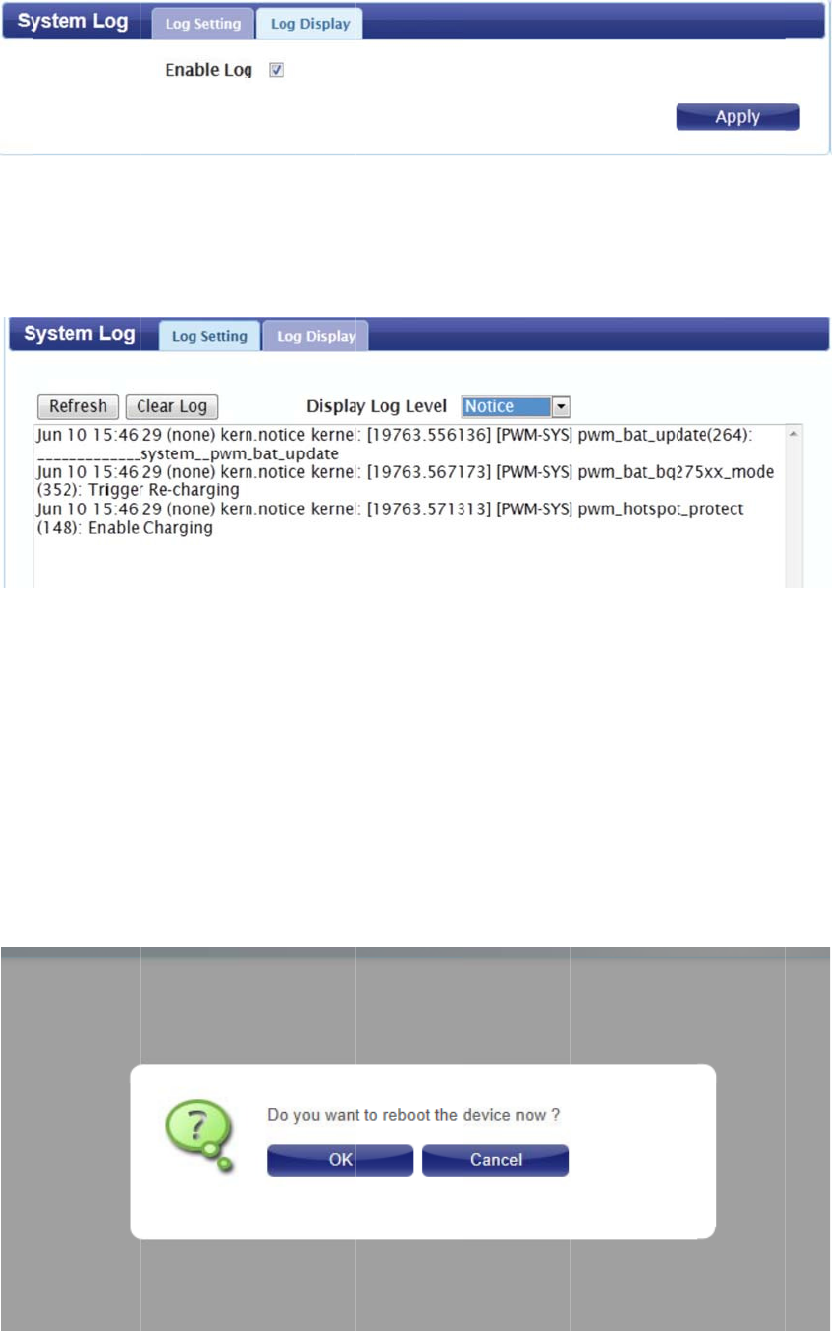
Log
En
a
Cli
c
Log
Re
f
Cle
Dis
dro
R
Setting
a
ble Log:
C
c
k Apply t
o
Displa y
f
resh: Clic
k
e
ar Log: Cl
i
play Log
L
p-down m
e
eboo
t
C
heck the
o
save the
k
to updat
e
i
ck to clea
r
L
evel: Sele
c
e
nu
t
box to en
a
current co
n
e
the log d
i
r
all log en
t
c
t the leve
a
ble the ro
u
nfiguratio
n
i
splay.
tries.
l of log ev
e
u
te
r
’s log-
k
n
.
e
nt which
y
k
eeping fu
n
y
ou wish t
o
nction.
o
view fro
m
m
the

Press ok to reboot the device
CEWarning:
UsershavetousetheconnectiontoUSBinterfaceswithUSB2.0versionorhigher.
Pleasemakesurethetemperaturefordevicewillnotbehigherthan40˚C
Thedeviceistestedfortypicalbodywornoperation.Theminimumdistancebetween
theuserand/oranybystanderandtheradiatingstructureofthetransmitteris
0.5cm.
DeclarationofConformity
We,错误!未找到引用源。,
Address:No.289,Sinhu3rdrd.,NeihuDistrict,TaipeiCity114,Taiwan
Declareunderourownresponsibilitythattheproduct:
Model:DWR‐810
Intendeduse:DC‐HSPA+LePetitRouter
ComplieswiththeessentialrequirementsofArticle3oftheR&TTE1999/5/EC
Directive,ifusedforitsintendeduseandthatthefollowingstandardshavebeen
applied:
1. Health(Article3.1(a)oftheR&TTEDirective)
EN62311:2008/EN62209‐2:2010
EN50566:2013
2. Safety(Article3.1(a)oftheR&TTEDirective)
AppliedStandard(s):
EN60950‐1:2006+A11:2009+A1:2010+A12:2011
3. Electromagneticcompatibility(Article3.1(b)oftheR&TTEDirective)
AppliedStandard(s):
EN301489‐1V1.9.2/‐7V1.3.1/‐17V2.2.1/‐24V1.5.1
4. Radiofrequencyspectrumusage(Article3.2oftheR&TTEDirective)
AppliedStandard(s):
EN301511V9.0.2
EN301908‐1V6.2.1/‐2V5.4.1
EN300328V1.8.1
AllthereportsoftheappliedstandardshavethePositiveOpinionofNotifiedBody:
PHONEIXTESTLAB,Königswinkel10D‐32825Blomberg,Germany
FCCWarning:
FCCRegulations:
Thisdevicecomplieswithpart15oftheFCCRules.Operationissubjecttothe
followingtwoconditions:(1)Thisdevicemaynotcauseharmfulinterference,and(2)
thisdevicemustacceptanyinterferencereceived,includinginterferencethatmay
causeundesiredoperation.
ThisdevicehasbeentestedandfoundtocomplywiththelimitsforaClassBdigital
device,pursuanttoPart15oftheFCCRules.Theselimitsaredesignedtoprovide
reasonableprotectionagainstharmfulinterferenceinaresidentialinstallation.This
equipmentgenerates,usesandcanradiatedradiofrequencyenergyand,ifnot
installedandusedinaccordancewiththeinstructions,maycauseharmful
interferencetoradiocommunications.However,thereisnoguaranteethat
interferencewillnotoccurinaparticularinstallationIfthisequipmentdoescause
harmfulinterferencetoradioortelevisionreception,whichcanbedeterminedby
turningtheequipmentoffandon,theuserisencouragedtotrytocorrectthe
interferencebyoneormoreofthefollowingmeasures:
‐Reorientorrelocatethereceivingantenna.
‐Increasetheseparationbetweentheequipmentandreceiver.
‐Connecttheequipmentintoanoutletonacircuitdifferentfromthattowhichthe
receiverisconnected.
‐Consultthedealeroranexperiencedradio/TVtechnicianforhelp.
Caution:
Changesormodificationsnotexpresslyapprovedbythepartyresponsiblefor
compliancecouldvoidtheuser‘sauthoritytooperatetheequipment.
RFExposureInformation(SAR)
Thisdevicemeetsthegovernment’srequirementsforexposuretoradiowaves.This
deviceisdesignedandmanufacturednottoexceedtheemissionlimitsforexposure
toradiofrequency(RF)energysetbytheFederalCommunicationsCommissionof
theU.S.Government.Theexposurestandardforwirelessdeviceemploysaunitof
measurementknownastheSpecificAbsorptionRate,orSAR.TheSARlimitsetby
theFCCis1.6W/kg.*TestsforSARareconductedusingstandardoperatingpositions
acceptedbytheFCCwiththedevicetransmittingatitshighestcertifiedpowerlevel
inalltestedfrequencybands.AlthoughtheSARisdeterminedatthehighestcertified
powerlevel,theactualSARlevelofthedevicewhileoperatingcanbewellbelowthe
maximumvalue.Thisisbecausethedeviceisdesignedtooperateatmultiplepower
levelssoastouseonlytheposerrequiredtoreachthenetwork.Ingeneral,the
closeryouaretoawirelessbasestationantenna,thelowerthepoweroutput.SAR
compliancehasbeenestablishedinthehostproduct(s)(laptopcomputers),testedat
5mmseparationdistancetothehumanbody,andtestedwithUSBslotconfigurations
includingHorizontal‐UP,Horizontal‐Down,Vertical‐Front,Vertical‐Back.Thisdevice
canbeusedinhostproduct(s)withsubstantiallysimilarphysicaldimensions,
construction,andelectricalandRFcharacteristics.ThehighestSARvalue,testedper
FCCRFexposureguidelinesforUSBdongle,asdescribedinthisuserguide,is
0.65W/kg.TheFCChasgrantedanEquipmentAuthorizationforthisdevicewithall
reportedSARlevelsevaluatedasincompliancewiththeFCCRFexposureguidelines.
SARinformationonthisdeviceisonfilewiththeFCCandcanbefoundunderthe
DisplayGrantsectionofwww.fcc.gov/oet/ea/fccidaftersearchingonFCCID:
KA2WR810A1.